














Colliers Securities offers a robust foundation in serving the needs of non-profits, units of state and local government and other tax-exempt entities.
For over 40 years we have served South Dakota’s local and state governments, school districts, counties and cities, underwriting over $6 billion in bonds for South Dakota public entities since 1990.
We look forward to serving your public finance needs!

Tom Grimmond
Sioux Falls, South Dakota
Phone
605.339.9800 | 800.339.1111 tom.grimmond@colliers.com

colliers.com find us under services

Toby Morris
Pierre, South Dakota
Phone
605.224.5557 | 877.224.5557 tobin.morris@colliers.com
Cover: Photo by Lynn Betts
FORT PIERRE, S.D. – The South Dakota Municipal League held its annual district meetings throughout the state in March and April.
The meetings allow municipal officials to renew old acquaintances, make new ones, learn about new legislation, and visit with representatives from state agencies and other elected officials.
The meetings were presided over by Harry Weller, 2024 SDML President and Mayor of Kadoka, who discussed the direction and future of the Municipal League. Sara Rankin, South Dakota Municipal League Interim Executive Director, spoke about the outcome of the 2024 Legislative Session and the effect new laws will have on South Dakota municipalities. Attendees also had access to additional resources and information, including the benefits of participating in the League’s risk-sharing pools.
At the end of the meeting, Weller conducted the election of each district’s chair and vice chair for the upcoming year. The district chair acts as a contact for and represents their district as a member of the SDML Board of Directors. Duties began immediately after the election. ■
District 1 – April 4, Sisseton
Attendance: Over 60; 11 cities represented
Chair: Mike Grosek, Webster Mayor (re-elected)
Vice Chair: Terry Jaspers, Sisseton Mayor (re-elected)
2025 Host: Watertown
District 2 – April 3, Madison
Attendance: Approximately 45; 6 cities represented Chair: Jameson Berreth, Madison City Administrator (re-elected)
Vice Chair: Michael Schulte, Volga City Administrator
2025 Host: Madison
District 3 – April 2, Harrisburg
Attendance: Approximately 90; 18 cities represented Chair: Derick Wenck, Harrisburg Mayor (re-elected)
Vice Chair: Elaine Johnson, Beresford Finance Officer (re-elected)
2025 Host: Dell Rapids
District 4 – March 21, Gregory
Attendance: Over 65; 11 cities represented Chair: Chandra Phillips, Winner Finance Officer (re-elected)
Vice Chair: Shauna Meyerink, Platte Finance Officer (re-elected)
2025 Host: Burke

District 5 – March 20, Wessington Springs
Attendance: Approximately 40; 3 cities represented Chair: Kristi Honeywell, Pierre City Administrator (previous vice chair)
Vice Chair: Linda Willman, Wessington Springs Finance Officer
2025 Host: Miller
District 6 – April 10, Groton
Attendance: Approximately 50; 8 cities represented Chair: Rick Boschee, Bowdle Mayor (re-elected)
Vice Chair: Brian Bahr, Groton Councilmember (re-elected)
2025 Host: Redfield
District 7 - March 19, Mobridge
Attendance: Over 75; 11 cities represented
Chair: Gary Weismantel, Herreid Mayor (re-elected)
Vice Chair: Gene Cox, Mobridge Mayor (re-elected)
2025 Host: Akaska
District 8 – March 28, Kadoka
Attendance: Over 35, 5 cities represented
Chair: Brittany Smith, Philip City Administrator (re-elected)
Vice Chair: LaTasha Buchholz, Kadoka Finance Officer
2025 Host: Fort Pierre
District 9 – March 27, Hill City
Attendance: Over 60; 9 cities represented Chair: Laurie Woodward, Custer City Administrator/ Finance Officer (re-elected)
Vice Chair: Misty Summers-Walton, Hot Springs Finance Officer
2025 Host: Custer
District 10 – March 26, Belle Fourche
Attendance: Over 60; 8 cities represented
Chair: Adam Hosch, Sturgis Deputy Finance Officer (re-elected)
Vice Chair: Gina Carpenter, Belle Fourche Human Resources Officer
2025 Host: Deadwood
PRESIDENT
Harry Weller
Mayor, Kadoka
1st VICE PRESIDENT
Carolynn Anderson
Finance Officer, Wall
2nd VICE PRESIDENT
Leland Treichel
Mayor, Roscoe
TRUSTEES
David Barranco
Councilmember, Sioux Falls
Paullyn Carey
Finance Director, Huron
Michelle DeNeui
Finance Officer, Spearfish
Lance Lehmann
Councilmember, Rapid City
Dawn Murphy
Finance Officer, Tea
PAST PRESIDENT
Amy Leon
City Manager, Yankton
Dist. 1 | Mike Grosek Mayor, Webster
Dist. 2 | Jameson Berreth City Administrator, Madison
Dist. 3 | Derick Wenck Mayor, Harrisburg
Dist. 4 | Chandra Phillips Finance Officer, Winner
Dist. 5 | Kristi Honeywell, City Administrator, Pierre
Dist. 6 | Rick Boschee Mayor, Bowdle
Dist. 7 | Gary Weismantel Mayor, Herreid
Dist. 8 | Brittany Smith City Administrator, Philip
Dist. 9 | Laurie Woodward
City Administrator/Finance Officer, Custer
Dist. 10 | Adam Hosch Deputy Finance Officer, Sturgis
Sara Rankin Interim Executive Director and Director of Member Engagement
Emilie Miller Director of Marketing and Communications
Lisa Nold Director of Risk Sharing Services
Lori Butler Director of Finance
Jackie Lopour Accounting Assistant
Rob Peterson Director of Municipal Electric Services
Krista Kerns Administrative Services Coordinator
SD Public Assurance Alliance
Lynn Bren Executive Director
Kristina Peterson
Deputy Director
Becky Brunsing Member Services Representative
Jerry Krambeck Member Services Representative
Paytra Nichols Underwriter
Thank you to Mobridge, Wessington Springs, Gregory, Belle Fourche, Hill City, Kadoka, Harrisburg, Madison, Sisseton, and Groton for hosting the 2024 district meetings.

The food was outstanding, the people were gracious, and programs were informative. I had the pleasure to meet many great people. My goal was to make all ten district meetings, and I did!
Applications for the new SDML executive director were due April 15. Now the process begins.
I hope you will check the magazine for upcoming SDML events that are of interest to you and make plans to attend.
Also, I look forward to the board meeting in late May in Kadoka. The beautiful Badlands will greet the board members.
Thanks again for the opportunity to be your president.
President Harry






















90 years is a long time! Congratulations to the South Dakota Municipal League on this major milestone!











The insight of the state’s municipal leaders in 1934 has ended up being very beneficial 90 years later and it’s still running strong with excellent leadership.

I spent over 20 years in the Spearfish Volunteer Fire Department, holding most of the offi cer positions before retiring around 1996. I had no intentions of running for a city council position, but a few city issues that I was aware of made me get a petition and run.



I lost on my first attempt but was successful the following year. Being involved in the fire department, I thought I thoroughly understood how local government works. How wrong I was. I had attended many city council meetings, but I just did not have a good understanding of what the actual duties as a council member should entail.




council members in the past two years. I remember the reporter asking her, “What are you going to do with all the newbies, and all the questions you are going to be asked?” Her answer was, “I am going to be very worried if they don’t ask questions.”



That’s about the time I was introduced to the SDML. I had not been sworn in yet, and the District 10 meeting was to be held in Deadwood. Beth invited and urged all the newly elected to attend. I declined because I did not understand the importance of it. SDML was an acronym that probably at that time I could tell you only what the "SD" stood for!






I remember getting a firm speech from her later on how important it would be to get involved, and she did not mince any words. So being the compliant person that I am (some may laugh at that one!), I quickly learned what the "ML" stood for and attended the SDML events from then on!


others from other communities across the state. It gave me insight into what my actual duties as a council member were. I was also having fun.



From my involvement in my very early years, I knew that I wanted to be a part of this organization. At that time, Beth was a past president of the League and Spearfish was very active in the SDML. Not only were our elected officials involved, but many of the Spearfi sh City staff were also active. Many served positions on the affiliate’s organizations and on the resolution committees.






I was always a very proud mayor; at times we had most of our council members involved and many city staff. The resources the SDML provides elected officials and city staff were –and still are – invaluable.








The local newspaper interviewed Spearfish’s finance officer at the time, Beth Benning, who was working with a fairly new mayor and several new


After attending my first convention I figured out that this was not only educational, but a very special benefit to be able to network and get to know

We traveled to many SDML events, with a lot of camaraderie and laughs! I believe it was in the late 90s when I was elected to the position of District 10 chair. I can honestly say that of all the boards I have been involved in, the SDML was definitely my favorite, and probably the most educating.


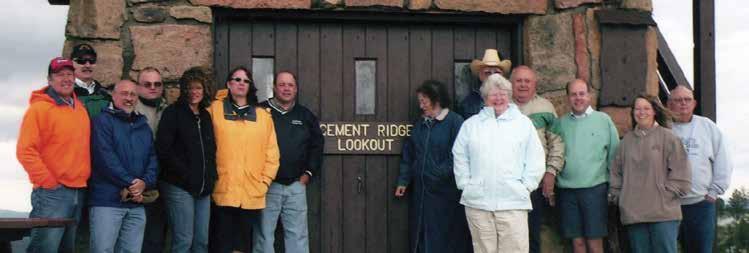





































and Dan Anderson (classmate that traveled to Germany with me). They rarely display the American Flag next to the German Flag at their City Hall, but Andrea displayed it special for our visit; I was very honored and impressed.




Having the opportunity to meet and get to know folks from all over South Dakota in so many different positions was very rewarding. It did not matter if it was the mayor of the largest city in the state, a trustee from one of the smallest towns, or a city employee, all were engaged and involved with the league. Politics did not play into our discussions; it did not make a difference what party you believed in, it was definitely nonpartisan.












I so much enjoyed the June SDML board meetings. I was also on the pontoon boats in Oacoma that Mike was referring to in his article. I was not on the one that ran out of gas, but I do think we may have run out of beer! If my memory is correct that was my first SDML June board meeting with many memorable others to follow. The sitting president picks the location for the June meeting, usually showcasing his or her community to the SDML board.





I was fortunate to be able to attend three National League of Cities conventions, one as Vice President and two as President. One was in Reno, Nevada, with Mayor Jim Knable from Mound City as the League’s Vice President. He was noted as the attendee from the smallest city in attendance - that one is quite the story!












Yvonne was very much known and respected nationally, even from the small state of South Dakota. I was so impressed with the Washington NLC convention, we budgeted for a couple of council members to attend the following year. It was also a great experience for them.



over 20 years, and I thank the SDML for putting me there. It resulted in many German friends visiting me in Spearfish and my making several trips to Mike’s Friendship City in Germany.




In 2000, I was elected mayor of Spearfish, still holding my position as a district chair moving up through the positions to become the league's President in 2007. What an honor, being the third President from the City of Spearfish, following Beth Benning and Judy Larson. Another Spearfi sh representative followed in 2012 when Paul Young, Spearfish council member, moved into the SDML President’s position.



The experience of getting to know others and being able to network was something I would not have had without being involved, and I am so grateful. Yvonne’s leadership as the executive director was also greatly appreciated.








In total, I served 3 years on the Spearfish City council and 13 years as mayor. My experience with the SDML helped assure me that I was in those positions for the right reason. I truly cared (and still do!) about my community and wanted to be a part of making the best possible decisions and policies to help mold our community into what it is currently today.






I cannot name all of the acquaintances I have made during my tenure with the SDML, but I do have to mention one: Mayor Mike! Webster has a Friendship City in Dewangen, Germany. If I had not met Mike, I would not have met many of Mike's German friends. That is a door that has been open to me for







With my time on the volunteer fire department, my years with the City of Spearfish, working with the SDML, and most recently the South Dakota Public Assurance Alliance, I have met so many that have made a large impact on me. My involvement with the SDML gave me the opportunity to know so many folks to network with throughout the state.


As many of the others have noted in their articles, I encourage you to take advantage of the resources that the South Dakota Municipal League has to offer. Get involved, volunteer for committees, attend the SDML events. You will not be disappointed by the rewards.






The South Dakota Police Chiefs’ and South Dakota Sheriffs’ Associations presented several awards to recognize heroism and support at the joint spring training held in Deadwood on April 16-18.
Brooke Greening, River District Counseling, Yankton

The Citizens Award of Merit award was given to Brooke Greening of River District Counseling, Yankton, to recognize her outstanding contributions to officer mental health and her efforts to improve hiring and retention practices for the Yankton Police Department.
“Brooke's dedication to supporting officer mental health and enhancing hiring and retention practices for law enforcement officers is
truly admirable,” said Jason Foote, Chief the Yankton Police Department. “Her commitment to researching best practices in these areas demonstrates a deep understanding of the challenges faced by officers and a genuine desire to make a positive difference.”
Greening, a licensed clinical social worker with a passion for officer mental health, is known for her ongoing efforts to stay informed about the latest developments in the field. She brings this passion and expertise to the many trainings she attends with the department.
“Her willingness to engage with officers experiencing trauma and provide them with the necessary support to return to work speaks volumes about her compassion and expertise,” said Foote.
Foote noted that Greening’s work not only benefits individual officers but also contributes to the overall well-being and effectiveness of law enforcement agencies. By focusing on hiring and retention strategies tailored to the unique needs of officers, she is helping to build stronger, more resilient law enforcement teams.
Officer Reece Walno, City of Spearfish Police Department

Officer Reece Walno with the Spearfi sh Police Department was selected as South Dakota Officer of the Year by the South Dakota Sheriff’s Association and the South Dakota’s Police Chief’s Association.
Officer Walno received the award in recognition of his exceptional work ethic and commitment to the community of Spearfish, completing a high-level narcotics investigation while also meeting the demand for high calls for service and continuing other proactive police activities.
During a seemingly routine traffic stop, Officer Walno observed multiple indicators of criminal activity that not only led to the seizure of drug paraphernalia, but also to the discovery of an encryption application commonly used for drug-trafficking on a confiscated mobile phone.
In the mobile phone application, Officer Walno observed information that suggested further narcotic activity using the United States Postal Service, which led to the seizure of a dark web marijuana parcel from Wyoming that was bound for Spearfish. In addition, the continued work and intelligence provided by Officer Walno later led to the seizure of a parcel from California, bound for Spearfish, which contained approximately one pound of suspected methamphetamine.
“Officer Walno’s investigative tenacity and attention to detail produced significant, well-documented intelligence which allowed law enforcement to seize more than a pound of controlled substances in addition to dark web marijuana from being distributed to Spearfish and other surrounding communities,” said Lieutenant Collin Smith, who nominated Walno for the award.

Smith noted that the settings within the application meant that once the phone was placed into rest mode, the information from the encrypted application would have been deleted.
“If Officer Walno did not take the time to locate the information in the application and conduct proper documentation during the initial search, the intelligence would have been lost,” Smith said.
Jason Foote, Chief the Yankton Police Department, and Brooke Greening, River District CounsellingDeputy Dan Eilers, Deputy Gary Nickerson, and Deputy Clayton Green, Hughes County Sheriff’s Office
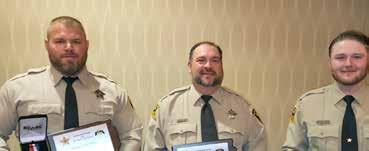
Three Hughes County Sheriff’s Deputies were awarded the Medal of Honor by the South Dakota Sheriff’s Association and the South Dakota’s Police Chief’s Association.
The Medal of Honor is awarded to law enforcement officers who willingly distinguish themselves through an act of courage, involving a risk of imminent serious injury or death, for the purpose of saving or protecting a human life.
Deputy Dan Eilers, Deputy Clayton Green, and Deputy Gary Nickerson each received the Medal of Honor for their actions on March 7, 2023, when responding to an aggravated domestic violence call in the Spring Creek area of northwest Hughes County.
The incident involved a six-hour long standoff in subzero temperatures following gunshots that were heard from inside the home. After multiple efforts to get the suspect to come out peacefully, a tactical team at the front of the home was supported by a second team along the side of the home. The second team consisted of Deputies Eilers, Green, and Nickerson.
As the first team was about to make entry, the suspect unexpectedly emerged from a side garage door armed with a handgun and directly engaged officers. As Team One engaged the suspect with gunfire, Team Two came under heavy crossfire as rounds penetrated the garage walls. Team Two recovered to safety under fire, regrouped, and then returned to assist in the effort to capture the suspect.
Ultimately, the suspect was captured without serious injury and taken into custody. He later pled guilty to domestic abuse and two counts of aggravated assault of a law enforcement officer and was sentenced to 25 years in the state penitentiary.
Roughly 30 city, county, state, and federal officers were involved in the successful capture. Hughes County Sheriff Patrick Callahan said he wished he could nominate each for an award.
“We have some of the finest law enforcement officers in the nation right here in South Dakota and Hughes County, and I’m very thankful to each of them for being there and answering the call to community service,” Callahan said. ■

Lawmakers passed 234 bills during the 99th Legislative Session. Here's a quick snapshot of the bills that will most affect our cities.
Under the category of general municipal issues, the surplus property limit has finally changed! After July 1, any surplus property appraised at $2,500 or less may be sold at private or public sale without notice.
If you regulate when campaign signs can be out during election years, you’ll need to be aware that the term will be longer now – you must allow them not less than 10 days before absentee starts.
You must equip each public access computer with software to limit minors’ access to obscene matter, or get your internet connectivity from a provider that has filter services; and, by Jan. 1, 2025, you have to publish the policy restricting access to obscene materials on your website or in the legal newspaper.
Municipalities are now required to pay city managers for 30 days after a dismissal, a change from the previous 14. Most likely you have a contact in place and the provisions of that contract will still need to be followed.
Protections were added for local elected officials, making it a Class I misdemeanor for a person to communicate any written or electronic threat to take the life or inflict serious bodily harm on the elected person or their immediate family.
The removal of restrictions on law enforcement from being able to inspect and search, seize, prosecute and discipline bad actors in the medical cannabis community. This ability, of course, will still require due process for a search or other action.
A bill passed clarifying that a municipality may impose a number of limitations on medical cannabis establishments, including limits on the proximity to sensitive use areas such as places frequented by children; and proximity of one establishment to other cannabis establishments. In addition, there is now additional clarification on taking adverse employment action, or refusing to hire a person, based solely on a positive test for cannabis if the person is in a safety sensitive position.
The requirements to be a legal newspaper were changed to allow print edition to be offered for free as long as there are at least 200 paid online subscribers. And, your rates for newspaper publication will no longer be set by the Bureau of Administration, there is now a formula in law that will govern what newspapers can charge.

One liquor bill that passed this year says that when you issue a special event license to a person who holds a liquor license, which can be done without a hearing, it no longer has to be used only in a publicly owned facility.
There were the usual number of bills to make exemptions to the sales tax, including two unsuccessful efforts to make the state rate reduction permanent, but there are also two ballot measures circulating. One would amend the Constitution, and one would put it in state law, but both say the same thing, that the state cannot tax the sale of anything sold for human consumption, except for alcohol and prepared food. Both also say municipalities may continue to impose these taxes. But, there is definitely a question about how that would work. Because of the Sales Tax Streamlining laws that allow us to collect sales taxes on remote sales, the state and municipalities have to have the same BASE, so they have to tax the same items. They do NOT have to have the same rate so the state can tax at 4 percent and the cities at 2%. If either of these measures passes, it would take legislative or court action to keep food in the BASE but have the state rate set at zero –leaving your sales taxes in place. It is not clear whether either measure would allow that type of legislation.
HB 1092 increased the 911 surcharge to $2 per line. 911 is an essential service and can only be done well by using very expensive technology and equipment and this should go a long way to stabilizing the funding for this. The bill did pass with a sunset on the increase – but the intent is to provide solid information from the 911 board over the next year, then remove that sunset and allow the increase to be permanent.
We are delighted by the passage of SB 187, which provides $7 million dollars to set up a statewide cybersecurity system for cities and counties. We are all aware of the threats to our electronic data, including ransomware and other ways to steal funds, but so far, we have each city and county out on its own trying to address this incredibly complex issue. The SDML will be working hard with the Attorney General’s Office of Consumer Protection and with Dakota State University to get this program up and running. ■
PIERRE, S.D. – The South Dakota Department of Agriculture and Natural Resources (DANR) has announced the Board of Water and Natural Resources has approved $172,554,815 in grants and loans for drinking water, wastewater, storm water, and solid waste projects in South Dakota.
The $172,554,815 total consists of $20,007,550 in grants and $152,547,265 in low-interest loans, including $10,986,600 in principal forgiveness to be administered by the Department of Agriculture and Natural Resources.
“I am pleased to announce this financial assistance is available,” said
DANR Secretary Hunter Roberts. “Safe and reliable water, wastewater, and solid waste infrastructure help protect our environment and strengthen communities for our kids and grandkids.”
Funds were awarded from DANR’s Drinking Water State Revolving Fund Program, Clean Water State Revolving Fund Program, Solid Waste Management Program, Consolidated Water Facilities Construction Program, and the Water Environment Fund to the following:
Aberdeen received a $10,000,000 Drinking Water State Revolving Fund loan to construct a 1.5-million-gallon

elevated tower and transmission pipeline in the northeast part of Aberdeen to address the need for additional water for existing users in that area of town. The loan terms are 3.5 percent for 20 years.
Alcester received a $1,530,000 Clean Water State Revolving Fund loan with $766,000 in principal forgiveness to televise the entire collection system to determine the condition of aging sewer lines, followed by relining and replacement of select lines and manholes. The loan terms are 3.75 percent for 30 years.
Aurora received a $1,751,000 Drinking Water State Revolving Fund loan,


a $1,030,800 Drinking Water State Revolving Fund Construction Grant, and $601,400 Consolidated Water Facilities Construction Program grant to construct a 250,000-gallon elevated water tower to replace the existing tower and 1,400 feet of water main. The loan terms are 3.75 percent for 30 years.
Clear Lake received a $3,500,000 Clean Water State Revolving Fund loan to replace the main lift station, valve vault, the force main pipe to the primary cell of the wastewater treatment system, and upgrades to 1,800 feet of storm sewer pipe and storm sewer structures. The loan terms are 3.75 percent for 30 years.
Clear Lake also received a $3,694,000 Drinking Water State Revolving Fund loan to replace existing water main and appurtenances in the northwest portion of the city including approximately
7,000 feet of PVC water main. The loan terms are 3.75 percent for 30 years.
Colton received a $323,748 Clean Water State Revolving Fund loan to replace a segment of sanitary sewer currently inaccessible due to proximity of adjacent buildings. This project will include connection to the existing upstream and downstream manholes, an addition of new manholes, and approximately 550 feet of PVC sanitary sewer main. The loan terms are 3.75 percent for 30 years.
Colton also received a $766,000 Drinking Water State Revolving Fund loan to replace approximately 1,180 feet of existing cast iron pipe servicing its business district. These improvements will reduce maintenance due to water main breaks on this segment of pipe. The loan terms are 3.75 percent for 30 years.
Dakota Mainstem Regional Water System received a $1,000,000 Water Environment Fund Appropriation grant to conduct a feasibility study to determine the viability and costs to provide water and system interconnects throughout east central and southeastern South Dakota to assure water availability to meet current user needs and provide for future growth.
Elkton received a $936,000 Clean Water State Revolving Fund loan and a $934,000 Clean Water State Revolving Fund Water Quality grant to continue replacing vitrified clay sewer main including 3,530 feet of sewer main and associated sewer structures. The loan terms are 3.75 percent for 30 years.
Elkton also received a $778,000 Drinking Water State Revolving Fund loan and a $222,000 Drinking Water State Revolving Fund Construction

grant to continue replacing cast iron water main piping south of the railroad tracks. The loan terms are 3.75 percent for 30 years.
Faith received a $1,250,000 Drinking Water State Revolving Fund loan with $620,000 in principal forgiveness to construct a new elevated water storage tower and make improvements to adjacent water mains to connect to the system. The city previously received funding in September 2022 and March 2021 for this project. The loan terms are 3.25 percent for 30 years.
Gary received a $2,015,822 Clean Water State Revolving Fund loan with $815,000 in principal forgiveness to televise the existing system and replace existing clay sanitary sewer main and manholes and rehabilitate lateral service lines. The loan terms are 3.75 percent for 30 years.
Green Valley Sanitary District received a $2,763,000 Clean Water State Revolving Fund loan with 100 percent principal forgiveness, a $237,000 Clean Water State Revolving Fund Water Quality grant, and a $2,000,000 Consolidated Water Facilities Construction Program grant to remove septic system and install a centralized sewer collection system.
Hudson received a $648,000 Clean Water State Revolving Fund loan and a $647,000 Consolidated Water Facilities Construction Program grant to replace wastewater collection line and sewer services as well as stormwater collection lines impacted by the wastewater line replacement. The city previously received funding in May 2022 for this project. The loan terms are 3.75 percent for 30 years.
Hudson also received a $1,107,000 Drinking Water State Revolving Fund loan with $782,000 in principal forgiveness to replace existing pressurized water storage tanks with a ground water storage tank and booster system, as well as replacing aging water distribution lines and installing water main loops. The city previously received funding in May 2022 for this project. The loan terms are 3.5 percent for 30 years.
Iroquois received a $1,900,000 Clean Water State Revolving Fund loan with $1,137,000 in principal forgiveness to replace the main lift station and force main. The loan terms are 3.75 percent for 30 years.
Kadoka received a $800,000 Clean Water State Revolving Fund loan to replace vitrified clay pipe in its sanitary sewer collection system and replace adjoining manholes and service lines. The city previously received funding in April 2022 for this project. The loan terms are 3.75 percent for 30 years.
Kingbrook Rural Water System received a $14,500,000 Drinking Water State Revolving Fund loan to construct 15.5 of transmission main and other facilities to enhance the reliability of the existing water system and add capacity to the DeSmet WTP service area. The loan terms are 3.50 percent for 30 years.
Lake Preston received a $2,653,600 Clean Water State Revolving Fund loan with $1,063,600 in principal forgiveness to replace aged sanitary sewer mains, sewer service lines, manholes and related appurtenances. The loan terms are 3.75 percent for 30 years.
Lake Preston also received a $2,492,100 Drinking Water State Revolving Fund loan with $2,118,200 in principal forgiveness to replace aged cast iron water mains, service lines, valves, hydrants, and related appurtenances. The loan terms are 3.5 percent for 30 years.
Lincoln County Rural Water System received a $3,078,000 Drinking Water State Revolving Fund loan to construct a second connection to Lewis & Clark Regional Water System including a meter building, process piping, site piping, electrical equipment, and all other necessary appurtenant work. The loan terms are 3.75 percent for 30 years.
Mobridge received a $7,350,000 Clean Water State Revolving Fund loan to construct new final clarifiers, repurpose existing tanks for new
treatment processes and to implement a sludge dewatering system to improve biosolids processing and disposal. The loan terms are 3.75 percent for 30 years.
Niche Sanitary District received a $220,000 Clean Water State Revolving Fund loan, a $821,000 Clean Water State Revolving Fund Water Quality grant, and a $656,000 Consolidated Water Facilities Construction Program grant to install a centralized collection system and connect to Summerset with a gravity sewer and lift station including new collection mains, service lines, and pumping systems. The loan terms are 3.75 percent for 30 years.
North Brookings Sanitary & Water District received a $1,597,450 Clean Water State Revolving Fund loan and a $761,550 Consolidated Water Facilities Construction Program grant to reline sanitary sewer lines and rehabilitate manholes throughout the wastewater collection system. The loan terms are 3.75 percent for 30 years.
Parker received a $1,669,000 Clean Water State Revolving Fund loan for wastewater improvements. The project will replace existing vitrified clay pipe with PVC and replace existing storm water infrastructure. The city previously received funding in April 2022 for this project. The loan terms are 3.75 percent for 30 years.
Parker also received a $1,215,000 Drinking Water State Revolving Fund loan and a $862,000 Drinking Water State Revolving Fund Construction grant to replace cast iron water main and loop portions of distribution system. The city previously received funding in April 2022 for this project. The terms of the loan are 3.75 percent for 30 years.
Parkston received a $1,500,000 Clean Water State Revolving Fund loan to install an ammonia removal system, a disinfection system, dredge treatment ponds, and restore wastewater treatment pond capacity. This project will improve effluent quality and allow the facility to meet discharge limits. The city previously received a funding
package in April 2022 for this project. The terms of the loan are 3.75 percent for 30 years.
Pierre received a $1,303,200 Clean Water State Revolving Fund loan and a $325,800 Solid Waste Management Program grant to construct a fourth landfill disposal cell to provide uninterrupted landfill disposal services to customers. The loan terms are 3.25 percent for 10 years.
Platte received a $370,000 Drinking Water State Revolving Fund loan for exterior rehabilitation of its water storage structures. The terms of the loan are 3.25 percent for 10 years.
Rapid City received a $35,000,000 Clean Water State Revolving Fund loan to build out its South Water Reclamation Facility and decommission its North Plant. The city previously received funding in April 2022 for this project. The loan terms are 3.5 percent for 20 years.
Seneca received a $440,800 Drinking Water State Revolving Fund loan with $321,800 in principal forgiveness to install new water meters and install several new water mains to loop lines, removing dead-end water main lines. The loan terms are 3.25 percent for 30 years.
Sioux Falls received a $23,130,000 Clean Water State Revolving Fund loan to continue the Basin 15 project by connecting the stopping point of phase 1 and extending infrastructure south of 12th street for approximately one mile. The Basin 15 sewer expansion project will open over 1,200 acres of land in the northwest part of Sioux Falls for future development. The loan terms are 3.25 percent for 20 years.
Sioux Falls also received a $590,000 Solid Waste Management Program grant to upgrade the supervisory control and data acquisition systems for the Landfill Leachate and Landfill Gas Systems Control Upgrades project.
Sioux Rural Water System received a $11,252,165 Drinking Water State Revolving Fund loan with $600,000 in principal forgiveness to construct parallel and new pipelines, replace pumps, install a well, provide service to an existing mobile home park, and construct a new ground storage reservoir. The loan terms are 3.5 percent for 30 years.
South Eastern Council of Governments received a $500,000 Solid Waste Management Program grant to recapitalize its regional revolving loan fund program. This funding allows SECOG to provide low-interest loans for solid waste management and recycling projects in the region.
Southern Black Hills Water System received a $1,584,000 Drinking Water State Revolving Fund loan and a $1,597,000 Consolidated Water Facilities Construction Program grant to install a new well, booster pump station, water storage tank, a new
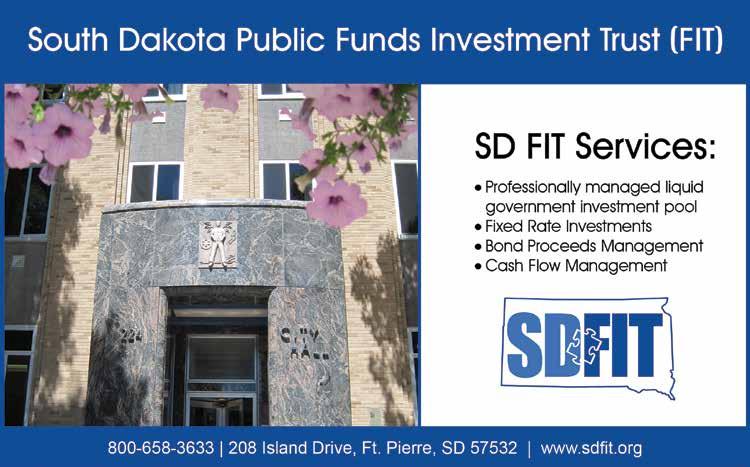
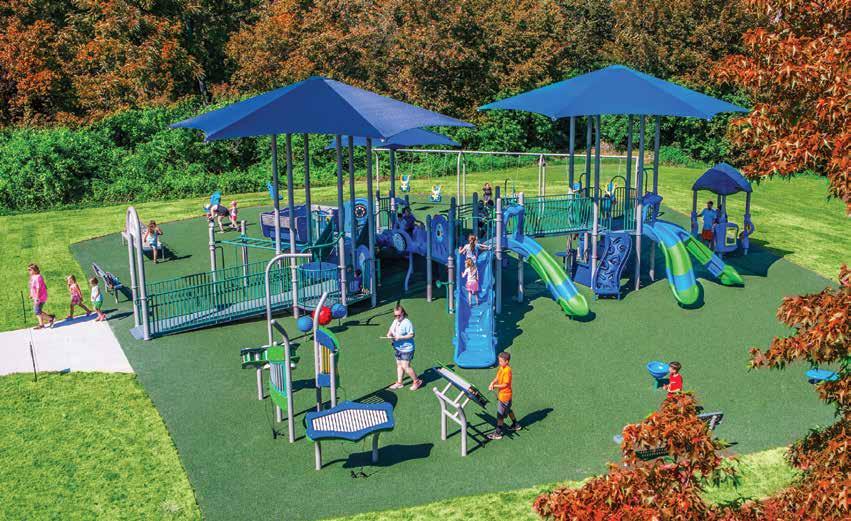
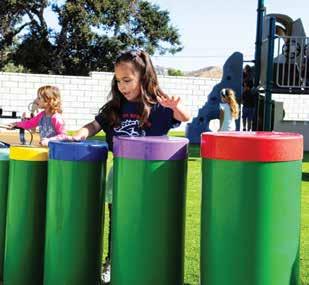


chlorination system, a SCADA system, and water main to connect the Paramount Point and Spring Creek Acres Service areas. Southern Black Hills Water System previously received a funding package in April 2022 for this project. The loan terms are 3.75 percent for 30 years.
Spring Creek/Cow Creek Sanitary District received a $3,627,880 Clean Water State Revolving Fund loan to construct a new wastewater treatment system to meet current permit limits and provide for planned future growth. The sanitary district previously received a funding package in April 2022 for this project. The loan terms are 3.75 percent for 30 years.
Vermillion received a $4,211,500 Clean Water State Revolving Fund loan to extend sewer services to the Northeast basin to allow for future development. The loan terms are 3.5 percent for 20 years.
Viborg received a $512,000 Clean Water State Revolving Fund loan to expand existing sanitary sewer collection and storm sewer systems to accommodate the development of future industrial sites. The project includes extension of PVC sanitary sewer main, installation of storm sewer main, and associated appurtenances. The loan terms are 3.75 percent for 30 years.
Water Investment in Northern South Dakota (WINS) received a $5,000,000 Water Environmental Fund Appropriation grant to provide up to 42.1 million gallons per day of treated drinking water to the northeast South Dakota region. The project is a collaboration between the city of Aberdeen, BDM Rural Water System, and WEB Water Development Association and consists of 148 miles of pipeline and associated water treatment and storage infrastructure.
Western Dakota Regional Water System received a $1,000,000 Water Environment Fund Appropriation grant to conduct a feasibility study to determine the viability and costs of providing over 58 million gallons of water per day throughout western South Dakota to assure water availability in case of a long-term drought, meet current user needs, and provide for future growth.
Winner received a $500,000 Solid Waste Management Program grant to purchase an existing solid waste handling facility and equipment to include a walking floor trailer, used semi tractor, four roll off containers, a mini excavator to facilitate the loading of garbage within the facility, and standardized solid waste containers for individual and commercial use.
Worthing received a $1,078,000 Clean Water State Revolving Fund loan and a $722,000 Clean Water State Revolving Fund Water Quality grant for the Wastewater Treatment Facility Improvements project. This project includes the rehabilitation of an existing lagoon to include
ammonia removal treatment equipment and constructing new sanitary sewer and storm sewer collection pipes. The city previously received funding in April 2022 for this project. The loan terms are 3.75 percent for 30 years.
Appropriations from the Water Environment Fund and Consolidated Water Facilities Construction Program are funded in part by revenues from the Petroleum Release Compensation Tank Inspection fee and the sale of lotto tickets. These appropriations provide funding for water, wastewater, and watershed projects. The Legislature annually appropriates dedicated water and waste funding for State Water Resources Management System projects in the form of Water Environment Fund Appropriations and the Consolidated Water Facilities Construction Program through the Governor’s Omnibus Water Funding Bill.
The Solid Waste Management Program provides grants and loans for solid waste disposal, recycling, and waste tire projects. The Legislature annually appropriates dedicated funding for the Solid Waste Management Program through the Governor’s Omnibus Water Funding Bill.
The State of South Dakota and the U.S. Environmental Protection Agency fund the Clean Water and Drinking Water State Revolving Fund Programs, which provide low-interest loans for wastewater, storm water, water conservation, nonpoint source projects, and public drinking water system projects. The programs are funded through a combination of federal appropriations, loan repayments, and bonds.
The board approved the funding at their meeting in late March in Pierre. ■

Local governments have a free tool to help them disseminate information to their citizens.
The Local Government Boards and Commissions website, established in 2021 by the South Dakota Municipal League, the Counties' associations, and Associated School Boards of South Dakota, allows local governments to post agendas, minutes, and other meeting documents.
Municipalities can use the website to any extent that they wish; from simply posting a link to the city website for meeting information to using it as a primary website for posting all meeting

information, meeting documents, and governing body information. The goal is to have all municipalities post, at a minimum, minutes for all council meetings.
Each municipality will need to create an account for the website, https:// sdlocalgov.appssd.sd.gov/cms/login. aspx. The account will be electronically approved by SDML staff. Once you're notified of approval, you'll be able to update your account profile and begin updating and posting information.
Each South Dakota Local Government Board and/or Commission will have at least one person assigned admin
privileges for the site. These privileges allow the user to post information about the board or commission they are affiliated with.
Information that can posted or edited includes:
• Meetings - Schedule, Agenda, Minutes, Other Pertinent Meeting Information
• Board/Commission Members
• Documents and Related Links
• Board Information
Once your city's account has been created on the site, email Sara Rankin at sara@sdmunicipalleague.org for approval and to get started. ■
D.A. Davidson & Co. is committed to strengthening the infrastructure and enriching the lives of people in our communities throughout South Dakota and across the nation. Our public finance bankers average over 20 years of experience in conventional fixed-rate debt financing, variable-rate bonds, creditenhanced structures and non-rated bonds.

Spring cleaning this year? Don’t forget to include your medicine cabinet! Many of us accumulate multiple medications over the course of a year, whether it’s over the counter medication for a pesky cold or stronger medication prescribed to us by our doctor for a more serious medical condition.
Spring is a great reminder to take a little bit of time to clean out your medicine cabinet of any expired, unused, or no longer needed medication.
Storing unneeded and unused medications in an easily accessible cabinet at home can put your loved ones, including children, adults, and pets, at risk for misusing medication or having an accidental overdose. Studies show that 65.9% of opioids are obtained by people through a friend or relative (either for free, for a charge, or from theft), so it’s important we take stock of our inventory and dispose of the medication we no longer need.
Keeping expired medication around in the case of needing it again is not advised. According to the U.S. Food and Drug Administration, expired medications become ineffective and dangerous due to a change in chemical composition that typically takes place over time and/or when the conditions in which the medications are stored changes.
Lastly, it’s important to refrain from keeping leftover prescription medication such as pain medication or antibiotics to give to others when they are ill or to selfmedicate. Medications prescribed by a doctor are intended to be used with the instructions listed on the bottle, and they can only be deemed safe when used correctly by the person they were prescribed to.


What are the types of medication that should be removed from your medicine cabinet?
• Any expired medication (including vitamins, supplements, creams, over the counter medicine and prescription medication);
• Any medication that is unmarked, not in the original container, and that you are unsure of its expiration date and what type of medication it is;
• Any medication that has changed in color, smell or taste or if it has been exposed to too much light as the medicine may be altered and therefore risky to ingest; and
• Prescription medication that you are no longer taking (pain medication for an acute condition, antibiotics, etc.).
What should you do with the medication you have removed from your cabinet?
• Drop it off at a drug take-back location so they can properly and safely dispose of the medication for you. Many pharmacies and police stations accept medication year-round, and there are several takeback sites in South Dakota that can be found using this link https://www.avoidopioidsd.com/take-action/ safe-medication-disposal.
• Dispose of your medication by using a Dispose RX packet. Once mixed into the medication bottle, the Dispose RX packet chemically and physically neutralizes the medication thereby making it ineffective as well as safe for the environment when thrown away. Dispose RX packets can be used with pills, capsules, tablets, liquids, and powders. Dispose RX packets can be ordered for free through this link https://helplinecenter. jotform.com/form/201986148733059.
• If you do not have access to a take-back site or a Dispose RX packet, check to see if your medication falls within the FDA’s Flush List found using this link https://www.fda.gov/drugs/ disposal-unused-medicineswhat-you-should-know/drugdisposal-fdas-flush-list-certainmedicines. Medications on this list are those that are sought after for their misuse potential and that can result in death from one dose if taken incorrectly. It is only advised to flush medications on this list if there are no other disposal methods accessible because of the greater harm these medications pose to human life if misused versus the environment if flushed.
• If you do not have access to a takeback site, do not have a Dispose RX packet, and your medication is not on the FDA Flush List, dispose your medicine in the trash utilizing these steps.
1. Remove the drugs from the original container;
2. Mix your medication with things such as used coffee grounds, cat litter, or dirt to make it unappealing to children and pets and unrecognizable to someone intentionally going through the trash looking for drugs;
3. Place the mixture in something you can close (a zippered plastic bag or container with a lid) to prevent the mixture from leaking; and
4. Throw the container in the trash.
It is extremely important to dispose of medication properly so that we can keep our loved ones and our environment safe.
This spring, make it a priority to get rid of unused, unneeded, and expired medication from your home. ■
PIERRE, S.D. - Historic preservation projects in Aberdeen, Dell Rapids, Garretson, Geddes, Pierre, and Vermillion were recently awarded matching grants from the South Dakota State Historical Society.
“This historic preservation grants program is designed to encourage restoration or rehabilitation of historic properties and is one more way we can promote and protect our history and culture,” said Jenna Carlson Dietmeier, Interim State Historic Preservation Officer.
The following projects were the most recent to be awarded grants to supplement their work:
• Aberdeen: Brown County Courthouse, built in 1904, was awarded $20,000 for repairs to the bell tower and masonry and tuckpointing work to the building’s exterior;
• Dell Rapids: First National Bank of Dell Rapids, built in 1889, was awarded $14,000 for tuckpointing to provide better structural integrity and basement rehabilitation;
• Garretson: Split Rock Bathhouse, built in 1936, was awarded $9,000 for rehabilitation work including caulk and tuckpointing on cracked mortar joints;
• Geddes: Papineau Trading Post, built in 1857, was awarded $5,000 for stabilization work including adding support beams to support the upper floor;
• Pierre: Farr House, built in 1904, was awarded $13,000 for repair and reconstruction of damaged historic box gutter, fascia, and soffit; and
• Vermillion: Vermillion Carnegie Library, built in 1904, was awarded $14,000 for building stabilization, prioritizing the rehabilitation of the damaged cupola.
These new recipients represent a total award amount of $75,000. These figures will be included in the 2024 year-end totals.
The grants are awarded through the State Historical Society’s Deadwood Fund grant program. Funding for the program is from Deadwood gaming revenue earmarked by state law for historic preservation projects throughout the state. The program is administered by the society’s State Historic Preservation Office in Pierre.
Deadwood Fund grants are awarded twice a year with grant application deadlines of Feb. 1 and Oct. 1. They are reviewed at the spring and winter meetings of the State Historical Society’s board of trustees.
For more information on the Deadwood Fund grant program, contact the State Historic Preservation Office in Pierre at 605-773-3458 or online at history.sd.gov/preservation/fundingopportunities.aspx. ■
The changeover in workforce in the water and wastewater sector is a growing challenge that will touch almost every system. While there are a number of ways that systems are looking to engage and recruit new workers, it’s also important to look at how the system itself is organized to improve recruitment and retention.
As the next wave of generational retirements comes upon us, it is noteworthy that many soon to be retirees came up through the ranks and spent their entire careers at one system. In many cases the system’s workflow by how these workers preferred to get the job done and they could get the job done.
Systems survived on the exceptional skills of experienced employees with decades of institutional knowledge. As these employees retire, the people and skills gap becomes increasingly apparent. While we can continue to look for new employees with exceptional skills there is also an opportunity for systems to review what they’re trying to accomplish and how they operate. Specific items to consider with these transitions and right-sizing existing positions are:
• Is there a bottleneck position where too many responsibilities run through a single person?
• Are there better ways to assign job functions to individual
employees that can help increase efficiencies?
• What important, but nonessential, tasks aren’t getting done throughout the system?
• Are employees getting the right feedback and opportunities for continued growth in skills?
While there is almost an endless number of items to review based on your system’s unique circumstances, the questions listed above provide a starting point to consider overall organizational structure. Answering the questions now can help with both transitions – the retirement of longterm employees and recruitment of their replacements. ■




“Financial plans are more than just about money. They’re really about education and providing you with the knowledge you need to make the best decisions for your community.”
Miranda Kleven, PE, AE2S Special Projects Engineer








Although they spend less than one hour a week together, Brandon Johnson will tell you that not-quitean-hour has made a big impact on both of them.
Johnson is part of the TeamMates Mentoring program in Pierre. He got involved with the program in 2021 when, through the school-based mentoring program, he was matched with a middle-schooler named Travis.
“He was shy at first, but that wasn’t surprising. We had to get to know each other,” said Johnson.
But after meeting over their lunch hours for three years to play cards and talk about their weeks, Johnson describes his mentoring experience as “rewarding—we’ve created a bit of a bond.”
And that’s the goal of the mentoring program – to build a connection between a mentor and a mentee for the benefit of both.
The TeamMates program was started by former University of Nebraska Husker football coach Tom Osborne in 1991 as a way for his collegiate football players to make a positive impact in the lives of middle schoolers.
“I think one of the things a mentor can do is provide a vision of what’s possible,” said Osborne.
Since that time, the program has expanded into hundreds of chapters spanning five states, including seven communities right here in South Dakota.
What’s more, the program has statistics to prove it is making a positive difference.
A 2023 survey of those who served as mentors shows more than 90% of mentors leave their weekly sessions in a better mood than when they arrived, and more than 80% return to their workplace more engaged.
As for the kids, more than 80% show an increased sense of hope while also experiencing improved academic improvements and fewer school absences.
“The program is absolutely a win for the entire community,” said Kim Leiferman, Pierre TeamMates Advisory Board Member. “The mentees are happier and realize improved achievements. The mentors are happier and feeling more hopeful. And our employers are benefiting from a more engaged workforce.”
Leiferman went on to say that she can’t imagine a better community investment.
“If you’d like this program in your town, and I hope you do, visit TeamMates.org. That’ll connect you with South Dakotabased staff who can help you establish a local chapter or become a mentor in your community.”
As for Brandon and Travis, their TeamMates relationship will continue for at least another year; Travis is set to graduate from high school in 2025.
After that, Brandon hopes to continue their bond and continue mentoring through the TeamMates program.
“I hope I can help another kid in some way. Even if it’s just an hour a week,” said Johnson. ■

Does your community need a ordable housing?
South Dakota Housing provides solutions for you.
If you haven’t recently reached out to your local conservation district and USDA Natural Resources Conservation Service (NRCS), you’re missing a free but valuable resource. That’s the reminder Angela Ehlers, Executive Director of Conservation Districts of South Dakota, has for city officials across the state.
“There’s a lot of opportunity for cities and small towns to improve urban landscapes,” Ehlers says. “That includes using sound soil health practices on city-owned land, as well as encouraging homeowners, businesses, and community volunteers to use soil health practices. The payback comes in many ways–– less damage to infrastructure because rain that falls stays in place instead of contributing to flooding; creating beautiful, natural grass areas that attract pollinators; and the good will that comes from demonstrating and educating citizens on the fine points of growing healthy food in healthy soils that result in better human health, to name a few.”

NATIVE PRAIRIE, POLLINATOR PROGRAMS IN SIOUX FALLS
Ehlers points to examples of partnerships with conservationists across the state. The City of Sioux Falls has reached out to the Minnehaha and Lincoln Conservation Districts and others to establish several native prairie buffer strips in parks.



The City of Sioux Falls and Minnehaha Conservation District are partnering to offer POLLINATOR KITS to residents. Their goal is to make it easy for residents to distinguish native plants as a landscaping feature in their yards. Photo: Alina Krone-Hedman, Minnehaha Conservation District.

The projects include educational signs that explain how the deep roots of native prairie plants stabilize soils and encourage stormwater infiltration. That improves water quality. Native plants, which are more resilient in droughts and need less maintenance than shallow-rooted, introduced plants like bluegrass, also bring diversity and create habitats for a variety of birds and wildlife, including pollinators.
The City of Sioux Falls Sustainability Program is also partnering with the Minnehaha Conservation District to offer Prairie and Pollinator Garden kits to residents.
“People were interested in having a pollinator plant area in their yards, but the seeds are expensive and most people have only a small area available,” explains Alina Krone-Hedman, Urban Conservation Education Coordinator for the district.
In their second year of the program, the city and district have sold 135 kits. For $15, residents get a kit from the district that includes enough seed to cover a 100-square-foot plot, an instruction
NRCS soil health specialist Kent Vlieger practices what he preaches at his home in Huron. He showcases native pollinator plantings in his front yard as well as cover crops in his garden. Photo: Kent Vlieger, NRCS.booklet, and a sign to explain the program’s benefits to neighbors.
“We haven’t had any complaints from residents,” KroneHedman says. The city and district are starting a five-acre community garden and educational space this year on city land near 72nd Street and Ditch Road in the northern part of the city.
“We’re showcasing soil health practices residents can use at home, and we’ll have a demo garden to compare soil health practices with garden spaces not using those practices,” Alina-Krone says. “Residents can rent small garden plots for a small fee––I think the best way to help people learn new practices is to give them hands-on opportunities.”
The educational area will also demonstrate raised beds, native pollinator plants, a high tunnel, alternatives to turf grass yards, and more, with plans for involvement from community groups.
“We really underestimate the soil and the impact it has on our lives,” says Rachel Lawton, Urban Conservationist for the NRCS in South Dakota. “The grasses, the trees, the flowers, the birds and animals, the pollinators––all the life we see is built from the soil,” Lawton says. “Clean air, clean water, all the food you grow, even the stability of your house


The Healthy Soil at Home publication can aid cities in promoting healthier soil in their community. The free 20-page booklet is filled with ideas and photos showing city residents, businesses, and small acreage owners how to develop healthy soil. View it online and order printed copies at www.WhereGoodThingsGrow.org.







are dependent on soil. And when those soils are healthy, everything works better.”
Healthy soil––with plenty of pore space for both air and water––absorbs rainfall as it infiltrates into the soil exponentially faster than compacted soil that often results from construction sites, including the yards surrounding newly built houses.
“That’s a big thing, to both city managers and homeowners,” Lawton says. “When rainwater is forced to run off the land rather than soak in, it’s going to carry soil, pesticides, herbicides, fertilizers, and more into water bodies.”
As the City of Sioux Falls continues to expand, Megan and Dan EisenVos would like the partnerships they’ve formed in producing food from their large, one-acre garden to be an example of reimagining land use within the city. Their nonprofit, educational, IronFox Farm borders the BNSF railway on the east side of the Big Sioux River’s Boulevard Greenway, within walking distance of downtown.
“The city has been supportive,” Megan says. “When we bought the vacant land, they helped get it rezoned as one lot and as a conservation space. That was a big help to us.”
A dietitian by trade, EisenVos and her husband share their passion for growing healthy food with their neighbors, especially children in the neighborhood. In their third growing season, Dan and Megan have invited third and fourth graders to help plant, tend, and harvest the garden each year. In the process, the children learn how to grow healthy food.
“We received a sustainability grant where we partnered with NRCS in a rainwater collection project,” Megan says. “The participants learned how they could save water and improve
water quality by keeping the rain that falls on the garden in the garden.”
IronFox Farm also partners with SoDak Compost, a nonprofit that makes compost from food scraps dropped off by more than 50 families.
“That composting is our number one nutrient,” Megan says. “When we transplant, students learn how valuable compost is as they put that compost around each plant. They also helped plant cover crops in the fall. We explain to them a cover crop covers damaged soil to help it heal like a bandaid covers a wound on their skin.
“We use straw and other mulch over the entire garden,” she continues. “The mulch protects against the rain and wind, and encourages water infiltration into the soil, and also makes a significant difference in lowering temperatures on hot summer days.”
Other practices include planting native grasses and flowers for pollinators and being mindful to rotate crops. A focus this summer will be community events at the garden. Every Wednesday evening from May through August, people are invited to visit the garden to hang out—and get their hands dirty if they choose.
“We think we’ve seen a difference in the soil already,” Megan says. “And it’s cool to share what we are learning with the kids. We hope we can be a model for neighborhood gardening in the city.”
Across the state in Rapid City, Joel Milos is thrilled he can grow his own food on city land through the parks department.
“I live in an apartment. Last year was my first for a larger garden; I pay $30 for a plot and a half, roughly 40 feet by 25 feet. It’s a lot more satisfying to eat what I’ve grown,” Milos says. “I’m trying to rotate tomatoes, carrots, peppers, green beans, and sweet corn, with a small space devoted to plants for pollinators. I don’t use pesticides, I have a compost bin,
 Privately-owned IRONFOX FARM near downtown Sioux Falls focuses on helping third and fourth grade students learn how to grow their own food.
Photo: Courtesy IronFox Farm.
Joel Milos keeps the soil in his COMMUNITY GARDEN PLOT in Rapid City covered with mulch or cover crops. Like many people living in an apartment, Milos wouldn’t be able to grow his own food without community gardens.
Privately-owned IRONFOX FARM near downtown Sioux Falls focuses on helping third and fourth grade students learn how to grow their own food.
Photo: Courtesy IronFox Farm.
Joel Milos keeps the soil in his COMMUNITY GARDEN PLOT in Rapid City covered with mulch or cover crops. Like many people living in an apartment, Milos wouldn’t be able to grow his own food without community gardens.
I mulch with straw, and I planted a cover crop last fall. I’m considering placing a clear plastic temporarily over certain areas to solarize weeds as they emerge this spring, and no-tilling into it afterwards.”
Milos is one of about 100 people who have plots in the community garden project that leases land from the city.
“People have told me they’ve been able to get the same plot year after year, so there’s some incentive here to build healthier soil on your little part of the world,” he says. “It’s been nice to meet people and be part of the community––a community garden is more than food.”
Master gardeners—involved in many community gardens across the state––would agree.
While conservationists from conservation districts and NRCS work mostly with farmers and ranchers to help improve croplands and grasslands, Ehlers says agency agreements with districts allow NRCS staff to help with urban projects.
“We’ve learned a lot from farmers and ranchers in the past 10 to 15 years about how they make their soils healthier and how that improves just about all resources in the countryside,” Ehlers adds, “and that knowledge transfers and applies to yards, gardens, and open spaces in the city." ■




South Dakota Farmers and ranchers know how to build healthy soils that are resilient and productive. The key practices on croplands apply to building healthy garden soils as well.

• Till less, or better yet, not at all.
• Keep the ground covered, always.
• Keep a living, growing root in the ground year-round.
• Strive for plant diversity, as in nature.
• Integrate livestock when possible.

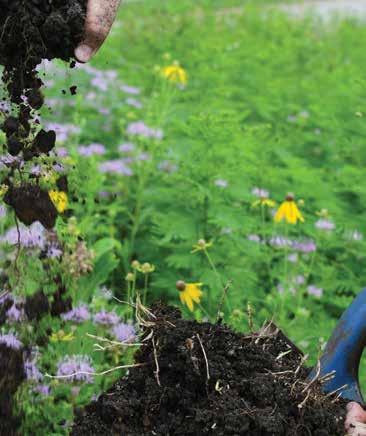
Since 1952


The South Dakota Department of Transportation (SDDOT) will host two public meetings to present the tentative 2025-2028 Statewide Transportation Improvement Program (STIP) on July 16 at 2 p.m. CST and July 18 at 7 p.m. CST.
Both meetings will be hosted virtually. No in-person public STIP meetings will be held this year. Information on how to join the virtual meetings is available at dot.sd.gov.
The STIP is a four-year program that lists projects developed through the coordinated efforts of the Department of Transportation, Transportation Commission, state and federal agencies, local and tribal governments, metropolitan planning organizations, public agencies, transportation providers, citizens, and other interested parties. The program identifi es highway and intermodal improvements to preserve, renovate, and enhance South Dakota's transportation system.
To learn more about the STIP, visit dot.sd.gov/projects-studies/ planning/stip. ■
SATURDAYS BLACK HILLS FARMERS MARKET, Rapid City
FALLS PARK FARMER'S MARKET, Sioux Falls
MARKET AT THE MERIDIAN, Yankton
STARTS MAY 24 MOUNT RUSHMORE EVENING LIGHTING CEREMONY, Keystone
CINCO DE MAYO FALLS PARK FIESTA, Sioux Falls
MAY 17-19
SOUND OF SILENCE TESLA RALLY, Custer
MAY 17-19
STATE PARKS OPEN HOUSE AND FREE FISHING WEEKEND, Statewide SD State Parks
• Due June 1
Redirect personal issues away from work and to helping resources.
• Legal
• Financial
• Substance Abuse Counseling
• In-person Counseling
✓ Marriage & Family issues
✓ Anxiety & Depression
✓ Post-Traumatic Stress
✓ Mental Health info@connectionseap.com
Call today: 1.800.779.6125 www.connectionseap.com
BLACK HILLS MOTORCYCLE SHOW, Deadwood
MAY 25-26 LET FREEDOM FLY INTERNATIONAL AIRSHOW, Pierre
BACK WHEN THEY BUCKED, Deadwood
MAY 31-JUNE 2
LAKE ANDES FISH DAYS, Lake Andes
MAY 31-JUNE 2
HISTORICAL FESTIVAL, Fort Sisseton Historic State Park, Lake City
• Provides funds to attend International Code Council (ICC) code hearings.
• Two scholarships available; one to an individual that has not previously attended an ICC Code Hearing, and one to a previous attendee.
• Can be used to attend the in- or out-of-state hearings of their choice.
• Must be a voting member of the SDBOA and ICC
• Due July 1
• Provides funds to attend the American Association of Code Enforcement (AACE) Conference, held Oct. 22-25 in Oklahoma City, Oklahoma.
• One scholarship available; includes conference registration and expenses related to conference registration, lodging, transportation, and meals.
• Must be a current member of SoDACE.
According to the National Weather Service, heat causes more deaths each year than any other weather event in the United States. Over the past 30 years, the number of heatrelated fatalities was far greater than deaths from tornadoes, floods, hurricanes, and other weather hazards.
Each year the media shares ideas to help people stay cool during heat waves. However, most of those suggestions involve staying OUT of the heat and in the air conditioning. What about those required to work in extreme heat? Getting safely through a hot day of work takes planning and preparation.
Exposure to extreme heat at work creates a risk of heat stress with the potential for occupational illnesses and injuries that vary from minor to life threatening. Heat stress can result in heat rashes, heat cramps, heat exhaustion, and heat stroke. (See resources at the end of this article for detailed information on heat related illnesses and appropriate first aid.) Working in the heat can also increase the risk of other injuries to workers as it may result in sweaty palms, foggy safety glasses, and dizziness.
Some workers may be at greater risk of heat stress than others. This includes those who are 65 years of age or older, are overweight, have heart disease or high blood pressure, or take medications that interact negatively with extreme heat. Finding what works best varies by employee and task. Each body responds differently and not every job that requires working outdoors is the same.
You can help your workers stay safe in the extreme heat by taking steps to ensure they understand what heat stress is, how it affects health and safety, and how it can be prevented. Below are some considerations for entities with employees who must work in extreme heat.


Explore reducing workplace heat stress by using engineering and administrative (work practice) controls. Engineering controls might include ventilation, air cooling, or fans to increase air flow.
Administrative controls allow changes to tasks or schedules to reduce heat stress. Examples of administrative controls:
• Limit time in the heat and/or increase time spent in a cool area.
• Reduce the physically difficult demands of the job.
• Require use of tools/equipment intended to minimize manual strain.
• Train workers to observe each other for signs of heatrelated illnesses.
• Have a plan (work periods/rest periods, working earlier or later in the day, etc.) in place for times of extreme heat.
Train employees before they begin working in the heat. Tailor information to specific worksite conditions. A heat stress training program for workers and supervisors might include the following:
• Signs and symptoms of heat-related illnesses and how to administer first aid and contact emergency medical services if needed.
• Requirement to immediately report any symptoms of heat related illness to the supervisor.
• Causes of heat-related illness and steps to reduce the risk.
• Effects that other factors (drugs, alcohol, health conditions, etc.) may have on tolerance to occupational heat stress.
Supervisors are in the role of enforcing work practices and policies. Even more supervisor support and attention may be needed during times of extreme heat. The supervisor should be prepared to:
• Implement steps allowing employees to gradually get used to the heat (See acclimate below.).
• Respond quickly when a worker has symptoms of heatrelated illness.
• Observe weather reports and respond to extreme heat advisories.
• Monitor employee fluid intake and require rest breaks.
Allow workers to get used to the hot work environment gradually. The body will adapt (e.g., sweating more efficiently) after gradual increased exposure to the heat over a period of days. Employers should ensure that workers are acclimated before they work in a hot environment.
Dehydration is a primary contributor to heat exhaustion. Workers need to hydrate before, during and after work. Employers should make water accessible near the work area and ensure a sufficient amount is available. Supervisors should encourage employees to hydrate frequently throughout the work shift.
For moderate activities lasting less than 2 hours in extreme heat, it is recommended that workers drink 1 cup (8 oz.) of water every 15–20 minutes. If sweating lasts for several hours, sports drinks containing balanced electrolytes might be added. It’s a good idea to limit caffeine intake as it can prompt dehydration and even add to the strain already placed on the body by hot weather.
It is essential that workers take rest breaks to cool down and hydrate. Taking breaks should be a requirement enforced by the supervisor. New and unacclimated workers need to be assigned lighter work and longer, more frequent rest periods. When temperature, humidity, and sunshine increase it may be necessary to shorten work periods and increase rest periods. This also applies if there is no air movement,



personal protective equipment is worn, and/or if heavier work is being performed.
In general, supervisors need to consider the kind of personal protective equipment (PPE) necessary to protect workers based on the task they are conducting. During extreme heat it is also necessary to anticipate the impact PPE might have on heat stress.
PPE protects workers from hazards, but it may also reduce the body’s ability to get rid of heat by sweating and may hold excess heat and moisture inside. In fact, the physical weight of some PPE might increase the physical effort needed to perform duties and can lead to the worker getting hotter faster. It is important to consider the type of PPE, length of time the worker is required to wear the PPE and environmental conditions (humidity, working in the sun or shade, wind speed, etc.).
PPE such as water-cooled garments, air-cooled garments, and cooling vests certainly help keep the body cool when working in the heat, but these items vary widely in ease of use, cost, and maintenance. More reasonably priced and easier to use options include personal cooling PPE (cooling
scarves, rags, towels, etc.) to be used during rest breaks. Core body temperature decreases relatively slowly, and simply stopping hard work will not result in an immediate decrease. Making cooling PPE available to increase the rate of heat removal from the body and subsequently the risk for heatrelated illness is a good choice.
When the temperatures rise but the job still needs to get done, employers need to take steps to ensure worker health and safety. Consider the suggestions within this article and don’t underestimate the seriousness of high temperatures on the body. Employees are your most important resource – take the actions necessary to help workers stay cool and work smart in the heat.
Questions about the information in this article can be directed to Safety Benefits, Inc. at 605.334.9567 or 1.888.313.0839. ■
Resources
• CDC - Centers for Disease Control and Prevention (www.cdc.gov)
• NIOSH - National Institute for Occupational Safety and Health (https://www.cdc.gov/niosh/index.htm)


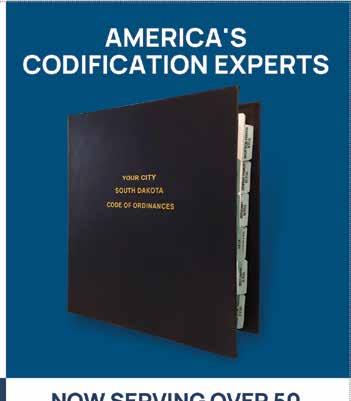

One of the best parts of serving on the administrative team for the SDPAA is having the opportunity to participate in a variety of different training and meetings with the local governments across South Dakota. I write this as we have just finished attending the ten SDML District Meetings over four weeks. Mixed in among these meetings have also been some SDACC District Meetings, and beyond that, some training sponsored by these, and other agencies have also been on the agenda. This article is going to be more of a reflection of what I have seen and learned over the past month. I hope that others who have attended can also look back on their experiences and have many of the same reflections!
As the executive director for the SDPAA, I had the opportunity to give a short presentation at each of the SDML District Meetings. As I did there, I will here, take a moment to express my appreciation for all of the people who sign up to serve their communities each day. I have and still do want each of you to know that we see the sacrifices that you make in an effort to make your community one that thought of as the place everyone would love to live. We understand that not everyone takes the opportunity to tell you how well they feel you’re doing and how much they appreciate you and your sacrifices.
The district meetings and other trainings sponsored by the SDML and SDACC/SDACO offer more than what is just on the agenda. We’d like to emphasize that while the agenda sets the stage for conversations and discussions, the opportunity for those attending the meetings and training goes far beyond the agenda topics.
I heard many conversations during social hours these past weeks with folks from different communities talking about challenges they were facing and sharing what could work well in curing those challenges. These meetings, and all the trainings that we attend, offer participants networking opportunities as well as engagement and reengagement opportunities. Someone coming to learn about cyber security solutions may very well find themselves helping someone else solve training management challenges. Coming together to reinforce a common bond and to collaborate on various challenges and opportunities is an especially important yet unintentional side effect of all the training and meetings that your affiliate organizations have to offer.
For those who didn’t have the opportunity to attend the meetings, I’ll share with you a few of the highlights from most of the speeches I gave over the past few weeks. What

follows is a little background, a little insight, and just some gold old fashioned common sense.
The SDPAA focuses strictly on public entities in South Dakota. We assist over 87% of local governments including cities, counties, townships, conservation districts and special purchasing districts such as sanitary, fire, water, and ambulance districts in protecting their assets. The SDPAA offers a proactive approach to claims management via a robust loss control and risk management program.
We appreciated the Legislature echoing our proactive approach to risks facing SD’s local governments when they passed SB187 which is intended to assist municipalities and counties in SD in protecting themselves against those bad actors who seek to infiltrate those systems. While the leading sponsors of this bill come together and work out the roadmap for putting the program in place, we continue to urge you to STAY VIGILANT! Trust NO ONE! We have seen an uptick in claims resulting from requests purported to be from a legitimate vendor seeking to update banking
Engineering + Environmental + Fiber & Broadband
Geospatial + Governmental Services
Land Development + Planning
information or purporting to be from an employee seeking to update automatic payroll deposit information. We urge you, no matter what role you play in this process, to stop, and call the requesting party. Do NOT email them. Call the requesting party to verify that they have in fact made the request. This is going to save you many sleepless nights. The problem with emails is that if the bad actor has accessed your account and is making these requests, the odds are they’ve been there a while and they’re already set up to respond to your confirmation email request. They have not yet likely figured out a way to intercept your call to a known number for these individuals or companies.
I’ll share with you a quick story, one that I didn’t share during the prior few weeks. We were preparing to provide a quote to an opportunity. I had not actually requested documents yet, but one of the people I had much engagement with had suddenly sent an email with the ‘documents I had requested.’ What I didn’t know is that the sender’s inbox had been hacked, and that the attachments likely contained a virus which would allow access into my inbox by the bad actors. The email looked absolutely legitimate. The sender’s email was correct, so I tried to call the number that was listed as the contact number in the signature of the email. The number was invalid. That was the first indication that this was not a legitimate request. I reached out to my main point of contact and let them know that there may have been an infiltration. I wasn’t the first person who had contacted them. They did later confi rm that the email had been compromised and that if you had opened the attachments that your machine may have been infiltrated as well. I was relieved that I had not opened the attachments, but still ran all of the virus scans on my machine and reached out to our IT Director to let him know what had happened.
The SDPAA prides itself in providing and seeking out innovative tools and resources for our Members. The SDPAA’s risk management and loss control program consists of various
live and online training opportunities, including specialized training and sample policies for our law enforcement folks. All Members of the SDPAA enjoy access to sample polies and procedures which are tailored to SD Public Entities. These sample policies offer a starting point for Members to then tailor further for their local communities and philosophies.
The most widely used resource offered by the SDPAA is the Government and Employment Practices Hotline. This hotline is used to aid local governments to answer a variety of questions that local counsel may need assistance in resolving. These hotlines have been especially crucial to assist in discussing elections questions as well as how to navigate marijuana in the workplace in light of litigation. We’re hearing that marijuana is going to make an appearance once again this fall.
As I took the opportunity to thank those who attended for all they do, I also have taken and will take here the opportunity to thank those on my team. I appreciate all the hard work and dedication that our SDPAA Administrative Team puts forth each day to make sure that the needs of the Members and Opportunities of the SDPAA are taken care of. A special thank you goes out to Deputy Director & Underwriter, Kristina Peterson;




Member Services Representative, Jerry Krambeck; Member Services Representative, Becky Brunsing; and Underwriter, Paytra Nichols.
The SDPAA is governed by an elevenmember board. On behalf of all the Members and Admin team, I’d like to thank Mike Wiese, Brown County Commissioner and SDPAA Board Chair; Lisa Katzenstein, Director of Administrative Services for City of Sturgis and SDPAA Board Vice Chair; Kathy Glines, Harding County Auditor and SDPAA Secretary / Treasurer; Justin Weiland, City Administrator for City of Tea and SDPAA At Large Representative; Sara Rankin, Interim Director SDML; Kris Jacobsen, SDACC Executive Director; Bill O’Toole, Director of Human Resources for City of Sioux Falls; Bruce Outka, Deputy States Attorney and Commission Assistant for Lawrence County; Paullyn Carey, Finance Officer for City of Huron; Chandra Phillips, Finance Officer for City of Winner; and Steve Harding, Mayor of Pierre. We appreciate the dedication and commitment that this board shows to the team and Members of the SDPAA.
Thank you all again for your time, your attention, and your service. If you have questions, please don’t hesitate to reach out. We are here to serve. ■
West Nile Virus Prevention - Mosquito Control
Grant, SD Dept. of Health
Due: June 1
Provides funds to help control mosquito populations and prevent the spread of West Nile Virus in local communities. Individual grants range from $500 to $20,000.
Learn more/apply: https://doh.sd.gov
Building Officials ICC Code Hearings Scholarship
Due: June 1
Provides funds for two association members to attend an in- or out-of-state ICC Code Hearing of their choice.
Learn more/register: www.sdmunicipalleague.org/ BuildingOfficials
Street Maintenance PWX Scholarship
Due: June 1
Provides funds for three association members to attend the American Public Works Association's Public Works Expo (PWX) in San Diego, CA, in August.
Learn more/apply: www.sdmunicipalleague.org/ StreetMaintenance
Code Enforcement AACE Conference Scholarship
Due: July 1
Provides funds for an association member to attend the American Association of Code Enforcement (AACE) Conference.
Learn more/apply: www.sdmunicipalleague.org/ CodeEnforcement
Let us know! Email us a 250-word description of your city’s notable achievement – a project, initiative, award, or individual honor. Include an image if possible. emilie@sdmunicipalleague.org
Code Enforcement Information and Training Conference
May 8-9, Fort Pierre
Registration: $50 - SoDACE member; $90 Non-member
Due: May 1
Annual spring meeting where members learn about and discuss current topics in code enforcement. Includes announcement of Code Enforcement Officer of the Year recipient.
Learn more/register: www.sdmunicipalleague.org/ events
Energize Conference, South Dakota State
University Extension Community Vitality
May 22-23, Hot Springs
Registration: $60-$115; $150 at the door
Works to energize South Dakota’s rural communities to develop new ideas and take action to improve their own communities.
Learn more/register: https://extension.sdstate.edu/ events
Human Resource School
June 11-12, Spearfish
Registration: $50 - SDGHRA member; $100 Non-member
Learn more/register: www.sdmunicipalleague.org/ events
Finance Officers' School
June 12-14, Spearfish
Registration: $75 - SDGFOA member; $100 Non-member
Learn more/register: www.sdmunicipalleague.org/ events
Building Officials' Summer Training
June 13-14, Box Elder
Registration: Free - SDGHRA member; $95 Non-member
Learn more/register: www.sdmunicipalleague.org/ events
Budget Trainings
June 18 in Rapid City; June 26 in Sioux Falls
Registration: $30
Provides elected official and finance officers with the tools they need to create and maintain the annual municipal budget.
Learn more/register: www.sdmunicipalleague.org/ events

















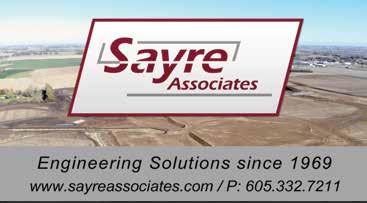
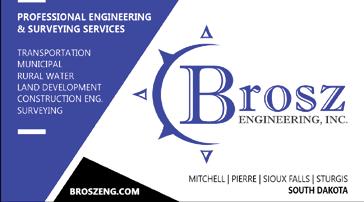




















PIERRE S.D. – The South Dakota Department of Agriculture and Natural Resources (DANR) has confirmed emerald ash borer (EAB) in Lennox, South Dakota. The announcement was made in early April.
The community of Lennox is in the existing quarantine area, which includes all of Minnehaha, Lincoln, Turner, and Union Counties. The quarantine is designed to slow the spread of EAB.
“Our team was alerted to a suspected infestation by an arborist,” said Marcus Warnke, State Forester, “After inspection, EAB was confirmed in the wood of an infested ash tree.”
EAB has been positively identified in three counties, Lincoln, Minnehaha,
and Union; and seven communities including Baltic, Brandon, Canton, Crooks, Dakota Dunes, Lennox, Sioux Falls, and Worthing.
The quarantine, which is in place yearround, prohibits the movement of firewood and ash materials out of the quarantined counties. Movement of firewood from any hardwood species, whether intended for commercial or private use, is also restricted. DANR has also established an external embargo on untreated firewood entering South Dakota from all states east of the eastern border of South Dakota and all counties where EAB is known to exist in other states.
“We all need to work together to slow the spread of EAB,” said DANR Secretary Hunter Roberts. “With the
summer camping season here, firewood is the most common way EAB is moved from one location to another. Please follow the quarantine and embargo restrictions and buy it where you burn it!”
If an ash tree is infested before it is cut, the wood may still contain EAB larvae. An individual split piece of ash firewood can have five or more adults emerge in the summer.
EAB is a boring beetle that feeds on all species of North American ash. It was first detected in the United States in 2002, and in South Dakota in 2018.
For more information or to report a suspected sighting, visit https:// emeraldashborerinsouthdakota.sd.gov. ■
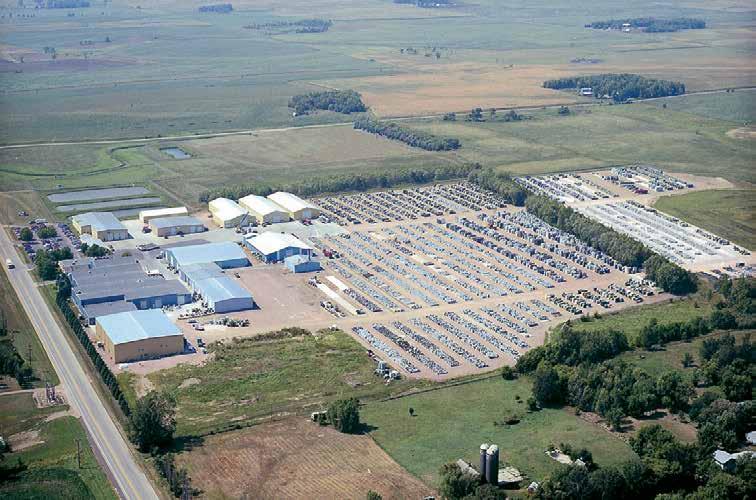


Founded at the beginning of the Black Hills Gold Rush, Deadwood has been at the center of iconic historical events.
Arguably the most famous poker hand in the history of the Old West happened on August 2, 1876, when James Butler “Wild Bill” Hickok was shot in the back of the head by Jack “Crooked Nose” McCall in the Nutall and Mann saloon, aka Saloon No. 10.
Other legendary figures graced the streets of Deadwood such as Calamity Jane, Preacher Smith, Seth Bullock, Potato Creek Johnny, Dora DuFran, and many others. Deadwood has embraced this history from the beginning with the activities such as the creation of the Days of ‘76 Celebration and the character Deadwood Dick telling stories to visitors in the early 1920s. Over a century later those events and many more continually tell the story of Deadwood while entertaining over 3.4 million visitors annually.
In 1961, Deadwood was designated a National Historic Landmark for its role as a rowdy and rambunctious mining camp and its importance in the taming of the American West. Thanks to the citizens of our great state, funding for the historic restoration and preservation of Deadwood was made available thanks to the passage of an amendment to South Dakota’s Constitution in 1988 that allows legal limited stakes gaming.
While funding has been capped since 1995, Deadwood continues to preserve, promote, and protect our rich and unique heritage through a strong historic preservation ethic with a variety of programs and partners. Practically every part of city government has a direct or indirect tie to preservation efforts. Some examples are in the form of archaeological investigations for a current FEMA project, outdoor interpretive signage on our evolving trail system,
historic exhibits at our recreation and aquatic center, retro trolleys in the form of a public transportation system, signage on our apparatus within the Fire Department, or operation of our Carnegie Public Library in its original building.
Beyond the City departments, our preservation partners present and support the history of our community through marketing by the Chamber of Commerce and Visitors Bureau, exhibits and programming in one our museum locations operated by Deadwood History, Inc., reenactors and stagecoach operations by Deadwood Alive, or historic programming in Outlaw Square.
History is our economic engine and Historic Main Street is our economic development park. Deadwood embraces its heritage and is busy preparing for an extravagant celebration for our 2026 Sesquicentennial. ■
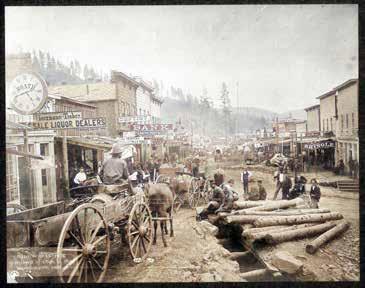

The Biden administration’s pursuit of its Green New Deal agenda jeopardizes Americans’ access to secure, reliable, and affordable energy. Energy costs have increased 35 percent under President Biden. The electric grid is struggling to keep up with demand. And new taxes and regulations are making life difficult for conventional energy producers. Nevertheless, the Biden administration continues to push its radical environmental agenda on the American people.
Recently, the Biden administration finalized restrictive new regulations on cars and trucks, creating a de facto mandate for the majority of new car sales to be electric vehicles (EVs) by 2032. There are a number of issues with this overreaching regulation, particularly that it will be incredibly costly for most Americans. The average cost of an EV is $52,000, which would be a significant expense for most families at any time, but especially now when compounded by the effects of inflation and higher interest rates.
Most Americans are also not convinced that an EV is right for them. South Dakotans expect a lot from their vehicles. We drive our cars and trucks long distances, put them to work on farms and ranches, and they face extremely cold temperatures. We also keep them for more than 14 years on average. Unsurprisingly, South Dakotans have not been eager to trade in their car or truck for an electric model. And with gas stations still vastly
outnumbering charging stations in our state, as they do in the rest of the country, the eight-year timeline the president envisions is unrealistic at best.
EVs would also place a heavy burden on our electric grid, which is nowhere near capable of supporting such a significant increase in demand. In fact, our nation’s energy grid is already being stretched by increased demand and the move away from conventional energy sources. We are rapidly approaching a situation in which we simply won’t have the ability to keep up with current electricity demand, and adding millions of electric vehicles on top of that could lead to widespread blackouts and brownouts, to say nothing of higher electricity prices.
In addition to Americans’ daily drivers, the Biden administration is also imposing new regulations on heavy-duty trucks, like those used in commercial trucking, to push truckers to switch to electric versions of their vehicles. By one estimate, the infrastructure and electricity costs of complying with the regulation could cost almost $1 trillion, which doesn’t include the cost of the new trucks themselves.
The future the Biden administration envisions is unrealistic, and forcing it on the American economy and households through heavy-handed regulations is just wrong. I have joined my Senate Republican colleagues in pushing legislation that would roll back these onerous and costly mandates, and we will see to it that the Senate takes an up-or-down vote on stopping these misguided regulations. ■
PIERRE, S.D. – A recent detailed analysis of visitor spending in every county in South Dakota shows that visitor spending is 21% higher than prepandemic levels (2019) and 4.9% higher than 2022 numbers.
Minnehaha County (29.3%) and Pennington County (19.3%) make up the largest share of visitor spending in South Dakota. Both the Southeast and Black Hills and Badlands regions are nearing $2 billion in visitor spending annually, with each exceeding $1.9 billion in 2023.
“People visit South Dakota from all over to enjoy our Freedom, experience the beauty of our open prairies, explore our parks, fish our waters, hunt our fields, and stand in awe at our monuments,” said Governor Kristi Noem. “Tourism is our second largest industry. And when tourism thrives, it helps our communities, businesses, and families succeed and flourish.”
The Black Hills and Badlands region experienced the strongest year-overyear visitor spending growth, exceeding 2022 visitor spending levels by 5.8%, an increase of more than $104 million. Custer, Lawrence, Haakon, and Jackson counties all exceeded 10% growth for the year.
The Southeast region also experienced strong visitor spending growth with a 5.2% increase, exceeding 2022 levels by nearly $100 million.
The Glacial Lakes and Prairies region grew visitor spending by 2.9% to reach just under $700 million and increasing over the prior year by almost $20 million. Brown County made up 29% of the spending for this region at almost $200 million.
The Missouri River region led all regions in growth compared to 2019 spending levels, with visitor spending growing by 24%. The region also experienced
a 3% increase when compared to 2022, exceeding the prior year’s visitor spending by $11.2 million. Hughes County experienced the most visitor spending activity in the region, reaching $97 million and making up 25% of the region’s total.
In 2023, visitor spending in South Dakota reached a record high of $4.96 billion, a 4.9% increase over 2022.
“Our industry has so much to be proud of,” said Hagen. “This industry supported more than 57,000 jobs and provided 2.2 billion dollars in household income to South Dakota families. These visitors and their dollars support diners, marinas, hotels and attractions in communities large and small in South Dakota.”
To view the full Tourism Economics County and Region Level Impact Report, visit SDVisit.com. ■


Airport ARFF/Operations/Maintenance Technician – City of Pierre, SD. Responsible for providing general daily oversight of airside operations by monitoring overall airfield safety, performs vehicle and equipment maintenance, airfield lighting maintenance and performs aircraft rescue firefighter duties. Maintains lighting systems, vehicles, equipment, grounds, structures, pavement and turf. Assists in overseeing wildlife management at airport through annual training, assisting in depredation permits, and overseeing bird strike report program. Maintains documentation and records of all actions taken on airfield to ensure compliance with FAA Part 139 certification requirements. Wage offer will be based upon actual education and experience. Comprehensive benefit package. UP TO A $3,000 HIRING BONUS! Learn more and apply at www.cityofpierre.org. Open until filled. EOE.
Airport Manager – City of Watertown, SD. Responsible for the overall administrative oversight, visioning, leadership, planning, coordinating, and management of the Watertown Regional Airport; to ensure essential services are provided; to maintain the public infrastructure; to provide for public safety, health and welfare; and ensures compliance with federal, state, and local regulations. Salary Range Grade 175: $83,283.20-$109,928.00. Application form and complete position description available at City Hall Finance Office or online at http://www.watertownsd.us/Jobs.aspx. First round review May 3, 2024. Open until filled.
Business Manager/Finance Officer – City of Pierre, SD. Directs the City’s overall financial management operations. Provides guidance to the City on financial matters including setting and establishing rates and fees, managing the City’s financial resources, maintaining responsible and mandated reserve accounts, assists in developing and balancing the annual budget, oversees the City’s payments to contractors, vendors, supplies, etc., conducts short and long-range planning and ensuring City compliance with all statutes relating to financial matters. Wage offer will be based upon actual education and experience. Comprehensive benefit package. Up to $2000 annually for educational reimbursement. UP TO A $3,000 HIRING BONUS! Learn more and apply at www.cityofpierre.org. Open until filled. EOE.
Chief of Police - City of Scotland, SD. Chief of Police: Responsibilities include management of the police department personnel and policies, enforce city ordinances, police patrol and other law enforcement duties. SD Law Enforcement Certified Required. Salary is dependent on qualifications and experience. Applications and job descriptions can be picked up at the City Finance Office located at 530 Juniper Street, Scotland, SD or call 605-583-2320. Completed applications can be sent to City of Scotland PO Box 316, Scotland, SD 57059. Open until filled. EOE.
City Administrator - City of Spearfish, SD. Responsible for directing, managing, and overseeing the day-to-day operations of the City of Spearfish while planning for and providing guidance to the Common Council regarding future operations. This is a full-time position. Starting salary range $145,121.60 - $190,403.20 plus excellent benefit package. Learn more and apply at the “Career Opportunities” page on the city’s website www.cityofspearfish.com. First review May 31. Open until filled. EOE.
City Administrator/Clerk - City of Waverly, MN. As the Chief Administrative Officer of the City, the City Administrator/Clerk provides leadership to the City staff and helps the City Council to define, establish, and attain overall goals and objectives of local government. The City Administrator/Clerk assumes the statutory duties of the Clerk. View the full position profile and apply at https:// www.ddahumanresources.com/active-searches. Please direct any
questions to Liza Donabauer at liza@daviddrown.com or 612-9203320 x111. Closes May 5.
City Administrator/Finance Director - Dallas Center, IA. Dallas Center (population 1,955), located in the desirable Dallas Center-Grimes School District and Iowa’s fastest-growing county, is seeking a skilled communicator and financially savvy individual to be its next City Administrator/Finance Director. Starting salary for candidates with preferred qualifications $90-100K. Preferred qualifications include a bachelor’s degree and five years of experience in municipal finance. Submit applications to hinsonapplications@gmail.com (please include “Dallas Center” in subject line). Application materials requested include: a cover letter, resume, salary history, and five work-related references. Detailed profile available at: https://bit.ly/dallascenter24. Apply by May 16, 2024. EOE.
Civil Engineer I, II, or III - City of Watertown, SD. Assists the Public Works Director/City Engineer with administrative oversight, leadership, planning, coordinating and implementation of the Engineering Division in order to ensure essential services are provided to plan, design, construct, and maintain the public infrastructure and provide for public safety, health and welfare. Salary depends on classification and ranges from $68,827.20 - $93,787.20. Apply to: Darci Nichols at Human Resources Office, 23 2nd Street NE, PO Box 910, Watertown, SD 57201 or submit via the City Website at www.watertownsd.us/ jobs. Applicants must submit a City Application, Cover Letter and Resume to be considered for the position. Open until filled.
Communications Officer - City of Spearfish, SD. Responsible for performing emergency and non-emergency communications functions. Requirements: Knowledge and level of competency commonly associated with completion of specialized training in

EXPERIENCE THAT PROVES. SERVICE THAT provides.
Land Surveying / Utility Analysis & Design / Landscape Architecture Street Design/ Agricultural Engineering / Water/
801 N. Phillips Ave., Ste 100 / Sioux Falls, South Dakota
201 Walnut Street / Yankton, South Dakota
LOCAL EXPERTS IN 605. 338. 6668 / 605.665.8092 / stockwellengineers.com
the field of work, in addition to basic skills typically associated with a high school education. Sufficient experience to understand the basic principles relevant to the major duties of the position, usually associated with the completion of an apprenticeship/internship or having had a similar position for one to two years. Starting wage $21.33 plus an additional $2.00 per hour rotating shift stipend ($23.33). Comprehensive benefits. ~Sign-On Bonus $4,000~ Learn more and apply www.cityofspearfish.com. Open until filled. EOE.
Communications Officer – City of Pierre, SD. Work as part of a team operating the Central South Dakota Communications Center, the 911-Emergency Dispatch Center for central South Dakota. Receiving calls for assistance from the public, document and dispatch appropriate public safety personnel for those calls. Receive, process and send radio communications for various Law Enforcement Agencies, Emergency Medical Services, and local Fire Departments. 40 hours per weekShift work. Comprehensive benefit package. UP TO $3000 HIRING BONUS! Learn more and apply at www.cityofpierre.org. Open until filled. EOE
Communications Specialist (E-911) - City of Mitchell, SD. Responsible for answering emergency and non-emergency calls and for dispatching appropriate personnel. Provides guidance to callers until emergency personnel arrive on scene; receives and transmits radio and telephone communication; monitors security cameras; and greets and assists visitors at the customer service window. No experience in the field is necessary; however, sufficient experience to understand basic principles relevant to the major duties of the position. Possession of or ability to readily obtain NCIC and EMD Certification. Starting wage:
$22.477 per hour. Full-time benefits. Applications: Human Resources Office, City of Mitchell 612 North Main Street, Mitchell, SD 57301. 605.995.8417, www.cityofmitchellsd.gov. Open until filled.
Community Development Director – City of Minneapolis, MN. Responsible for the overall leadership and management of the department, which includes staff working in the areas of planning, building inspections, code enforcement and environmental initiatives. Contributes to the overall direction and operation of the City organization as a member of the senior management team and plays a lead role in economic development efforts, along with external consultants and the City Administrator. The position involves significant interaction with elected officials, appointed Commissioners, local businesses, and IGH residents, as well as cross-departmental work with members of the City’s six other departments. View the full job description at https://www.ddahumanresources.com/active-searches. Closes May 2.
County Administrator - Becker County, Detroit Lakes, MN. Directs and coordinates administration of the county government in accordance with policies and goals as determined by the County Board of Commissioners. Education and Experience: Bachelor’s degree from a four-year college or university. Four (4) years of experience as an Administrator and/or ten (10) years in a senior department head/ supervisor role supervising staff is preferred. A master’s degree and experience in county government are preferred. View the full position profile and apply at https://www.ddahumanresources.com/ active-searches. Please direct questions to Liza Donabauer at liza@ daviddrown.com or 612-920-3320 x111. Closes May 5.

Dental Assistant – City of Sioux Falls, SD. Embark on a rewarding dental career with us! Be a part of a team dedicated to transforming oral health and overall well-being of patients in our community. Make a difference in a role that‘s both fulfilling and impactful! Assist dentists and hygienists in providing dental care and treatment of patients. Perform duties in the fields of chair-side assisting, reception, infection control, inventory, and records. The current vacancy is in the front desk area to support business transactions. Employee may also be expected to provide care chair-side as needed. Apply online at www. siouxfalls.gov/careers. Closes May 6.
Dental Hygienist – City of Sioux Falls, SD. Perform professional dental care in the field of dental hygiene, including all related clinical procedures and broad responsibility for clinical and community dental health education activities. HIRING RANGE DOQ: $31.78 - $45.11 hourly. This position is eligible for a hiring incentive of up to $4,000. Learn more and apply online at www.siouxfalls.gov/careers. Closes June 3.
Development & Marketing Coordinator - City of Freeman, SD. Responsible for managing social media and websites, develop and implement marketing strategies to promote Freeman, and actively participate in and collaborate with local and state organizations to support economic development efforts to draw visitors to our community. The ideal candidate will be self-motivated, detailoriented and able to work independently. If you are passionate about promoting economic growth, have a creative mindset and excel in digital marketing, this role is perfect for you. Pay is dependent on qualifications and experience. Interested candidates are invited to submit their resume to lisa@cityoffreeman.org or apply online at cityoffreeman.org/employment. Open until filled. EOE.
Executive Director - Kandiyohi County Economic Development (KCED), Willmar, MN. With a passion for rural Minnesota, the Executive Director will take a leadership and coordinating role in cooperation with other public, private, governmental, and educational organizations and agencies, encouraging the retention and expansion of existing businesses and the recruitment of additional businesses to Kandiyohi County. This position is responsible for leading efforts in retention, expansion, and location of businesses in the County. Salary: $100,000 to $130,000. View the full position profile at https://www. ddahumanresources.com/active-searches. Closes May 19.
Finance Officer – City of Delmont, SD. Responsible for maintaining financial, accounting, administrative and personnel services for all departments, in order to meet legislative requirements and support municipal operations. Reports to the Mayor and Council and is responsible for preparing financial statements, maintaining cash controls, preparing the payroll and personnel administration, purchasing, maintaining accounts payable and managing office operations. The Finance Officer is the official responsible for keeping all papers and records of the municipality. Must work within the Town of Delmont’s policies/procedures/ordinances and in compliance with South Dakota Codified Law. Questions: Barb Dozark, 605-779-2621, delmontfinance@midstatesd.net. Application and resume may be sent to: Delmont Finance Office, PO Box 202, Delmont, SD 57330. Open until filled.
Human Resources Director - Benton County, MN. Under the direction of the County Administrator, the Human Resources Director is responsible for the overall strategic development and administration of operations and planning, formulation, recommendation, implementation, and maintenance of human resource programs, systems, and services County-wide. Salary: $93,413 to $128,149. View the full position profile at https://www.ddahumanresources.com/ active-searches. Closes May 15.
Ice Arena Manager, Prairie Lakes Ice Area – City of Watertown, SD. Responsible for the administrative oversight, leadership, planning, coordinating and control of the Prairie Lakes Ice Arena. Responsibilities include managing and supervising programs, personnel and the facility. Under the direction of the Parks and Recreation Director, this position provides information to the public regarding ice arena activities; prepares and administers budget; and develops and implements Prairie Lakes Ice Arena goals and objectives. Application Forms and complete position descriptions are available at City Hall Finance Office or online at http://www.watertownsd.us/Jobs.aspx. Salary Range Grade 170: $75,712.00-$99,902.40. First round review May 3, 2024. Open until filled.
Patrol Officer - City of Mitchell, SD. Responsible for the enforcement of federal, state, and local laws and the protection of life and property. Some of the job duties include: patrol the city to detect and deter criminal activity and traffic violations and to provide assistance as needed; monitors commercial and residential areas for signs of criminal activity; responds to calls for service, including domestic disputes, assaults, burglaries, traffic accidents, lost or missing persons searches, public service requests; completes required reports and forms, including accident and incident reports. Starting wage: $27.386 per hour plus benefits. Applications: Human Resources Office, City of Mitchell, 612 North Main Street, Mitchell, 57301 605.995.8417, www. cityofmitchellsd.gov. Open until filled.
Patrol Officer – City of Pierre, SD. Performs law enforcement & public safety duties as necessary to maintain law & order in the City of Pierre. Must be at least 21 years of age, have a high school diploma or GED, & pass the police entry level examinations including a background investigation. Prior experience in law enforcement is desirable. Certified officer preferred. Up to $2000 annually for educational reimbursement. Up to $6000 hiring bonus. Comprehensive benefit package. Learn more and apply: Human Resources Office, City of Pierre, Box 1253, Pierre, SD 57501, (605)773-7429, www.cityofpierre. org. Open until filled. EOE.
Patrol Officer – City of Watertown, SD. Performs general duty police work for the apprehension of criminals, prevention of crimes, protection of life and property, and general enforcement of all laws and ordinances on an assigned shift under general supervision. Duties may also include in-depth investigation of criminal offenses as assigned. Performs duties in compliance with all state and federal laws, standards, and guidelines and departmental policies, procedures, and directives. Maintains conduct toward individuals, which displays a firm and fair attitude, respect for personal rights, and concern for safety. Salary: Grade 150- $28.58 - $32.18 / hourly DOE. Full description at http://www.watertownsd.us/Jobs.aspx. Open until filled. EOE.
Police Officer – City of Box Elder, SD. Join our team at the City of Box Elder, where we're seeking dedicated individuals to uphold our commitment to excellence, teamwork, and respect. As a member of our highly trained and professional force, you'll play a crucial role in enforcing federal, state, and local laws while safeguarding the lives and property of our community members. This position will start at $27.14 hourly depending on experience and qualifications, plus benefits. Become part of a culture where camaraderie and professionalism thrive. Join us in protecting and serving the vibrant community of Box Elder. Learn more and apply on the Human Resources page at www. boxelder.us. Open until filled.
Police Officer – City of Huron, SD. Under the general, and occasional, direct supervision of the Patrol Sergeant, or Captain, is responsible for protecting the law-abiding citizen and enforcing the law through ongoing police work in the city. Work varies, exercising judgment within well established procedures and standards. See full description and apply at https://huronsd.gov/Jobs. Open until closed.
Police Officer - City of Spearfish, SD. Enforce local, state, and federal laws, prevent, and suppress crime and accidents, and promote public safety through community policing principles. Responsible for the investigation of criminal cases as assigned. Requirements: Knowledge and level of competency commonly associated with completion of specialized training in the field of work, in addition to basic skills typically associated with a high school education; possession of or ability to readily obtain South Dakota Law Enforcement Certification. Full-time position. Starting wage: $30.13 per hour. Competitive benefit package. $6,000 sign-on bonus. Housing allowance. Full description and apply at www.cityofspearfish.com. Open until filled. EOE.
Project Inspector, Engineering – City of Spearfish, SD. Responsible for providing project management for city projects, including construction inspection, quality control, and surveying/staking as necessary. Wage range: $28.68 - $34.95 per hour; Competitive benefits package. Learn more and apply at www.cityofspearfish.com. Open until filled. EOE.
Public Works Assistant Director – City of Rapid City, SD. Responsible for providing senior-level leadership for the Divisions and programs of the Public Works Department, including direct supervision of Division Management, subordinate staff, and operations, under the general supervision of the Public Works Director. Develops policy guidelines and reviews department and division budgets. Supervises the development of long-term goals and capital improvement
Public Works Director (part-time) – City of Delmont, SD. Performs work in maintenance of all phases of water distribution and supply, wastewater collection system and lagoon, maintenance and repair of streets and alleys, maintenance of parks, dump ground, any and all city property. Questions: Barb Dozark, 605-779-2621, delmontfinance@ midstatesd.net. Application and resume may be sent to: Delmont Finance Office, PO Box 202, Delmont, SD 57330. Open until filled.
Public Works Laborer – City of Groton, SD. Applicants must be a US citizen, have a high school diploma or GED certificate, and possess a valid driver's license. Must be able to acquire a commercial driver's license and the necessary water/wastewater certifications within one (1) year of employment. Benefits package includes medical insurance, life insurance, and SD Retirement. Starting wage is DOE. For more information, please see https://www.grotonsd.gov or reach out to city. doug@nvc.net. Open until filled.
Public Works Maintenance – City of Philip, SD. Assist in all phases of maintaining the city streets, water distribution and wastewater system. Assist with the maintenance of public buildings and open spaces including the airport, rubble site and swimming pool. Knowledge and experience with all types of equipment is desired. Must hold a valid SD driver’s license. State water and wastewater certifications, and pesticide license must be obtained within two years of employment. Full time position. Wage DOE with an excellent benefit package. For more information, contact City Administrator Brittany Smith at 605859-2175 or cityadmin@philipsd.us Job description and applications at https://www.philipsd.us. Open until filled. EOE.

At Woods Fuller, we pride ourselves on being your go-to strategic partner for all legal matters. Count on us as the beacon of legal prowess, providing top-tier services while always considering your budget. Our specialty is navigating the complexities of administrative and regulatory law, public policy, and government relations. Backed by our seasoned attorneys' extensive experience, we ensure you have the trusted authority you need.
Staff Engineer - City of Spearfish, SD. Responsible for performing Computer Aided Drafting (CAD) activities, providing engineering support activities involving both office and field work and administering the city’s floodplain ordinance. Full-time position. Salary range: FE $72,696.00 - $82,243.20 annually, DOQ or PE $80,225.60 - $88,566.40 annually DOQ. Competitive benefit package. Apply on the “Career Opportunities” page on the city’s website www.cityofspearfish.com. Open until filled. EOE.
Traveling Code Enforcement Officer - Code Enforcement Specialists. Code Enforcement Specialists, a rapidly growing independent company specializing in code enforcement for small and medium sized communities, is looking for an individual willing to do some travel and perform code enforcement services. Excellent pay and hours are flexible. Experience is not necessary, but a background in law enforcement would be helpful. On-the-job training is provided. Please inquire at (605) 208-0786 for details.
Utility Billing Technician – City of Pierre, SD. Responsible for accurate and timely utility billing, as well as independently and proactively identifying and troubleshooting problems and customer concerns. Performs the utility billing functions as well as playing a key role in customer service; maintains all meter and utility account records, energy assistance contracts, and processes utility service orders. Manages the Bright Energy Solutions Rebate Program. Alternately balances registers and reviews and posts the daily bank deposit. Requires strong systems, analysis, and customer service skills. Wage offer will be based upon actual education and experience. UP TO $3000 HIRING BONUS! Comprehensive benefit package. Apply to:
Human Resources Director, P.O. Box 1253, Pierre SD (605) 773-7429, www.cityofpierre.org. Open until filled. EOE.
Water Plant/System Specialist – City of Pierre, SD. Responsible for the operation and maintenance of the City’s new state of the art Water Treatment Facility and distribution systems. Qualified applicants must have the ability to learn water treatment techniques and be able to perform a multitude of hands-on maintenance activities that pertain to drinking water systems. Comprehensive benefit package. UP TO A $3000 HIRING BONUS! Wage offer will be based upon actual education and experience. Apply to: City of Pierre Human Resources Director, PO Box 1253, Pierre SD 57501, (605)773-7429, www.cityofpierre.org. Open until filled.
The SDML office will be closed Memorial Day State Holiday MAY 27

First meeting in May – The financial officer is required to make an annual report to the governing body no later than the first regular meeting of May each year. The report must include the receipts, expenses, and financial condition of the municipality, including the amount of funds in the treasury at the time of making the report and where and in what amounts such funds are deposited or invested. The report shall be published in the official newspaper within thirty days after the report is made to the governing body or on completion of the annual audit.
May 2024
By the last day of May each year, the finance officer shall file a copy of the report with the Department of Legislative Audit. (SDCL 9-22-21; See Hdbk., sec. 12.080)
No later than May 1 – The liquor tax reversion must be made. (SDCL 35-5-22; See Hdbk., sec. 11.600)
May 1 – Special assessment installments which are payable under either the Plan One or Plan Two options become delinquent. (SDCL 9-43-109; See Hdbk., sec. 12.160)
First meeting following election – Except as otherwise provided, every officer of the municipality will begin to discharge the duties of the office as soon as the officer has qualified by filing an oath or affirmation of office. The oath must be filed within ten days after the first meeting of the month following the election or appointment. (SDCL 9-14-5; See Hdbk., sec. 5.115)
First meeting following election – Appointed municipal officials are usually appointed. The appointment may be annual, or for an interval determined by the governing body. (SDCL 9-14-3)
First meeting following election – In municipalities having the mayor and common council form of government, the council must elect a president and vice-president for the ensuing year. (SDCL 9-8-7; See Hdbk., sec. 2.520)
First meeting following election – In municipalities governed by a mayor and four commissioners, the board must designate by a majority vote, the following commissioners: Public Safety, Public Works, Utilities, and Finance and Revenue. Commissioners are assigned areas of responsibility under the law. (SDCL 9-9-18 to 9-9-24; See Hdbk., sec. 2.590)
First meeting following election – In municipalities governed by a mayor and two commissioners, the board shall by a resolution adopted by a majority, assign and apportion between the members, all duties that are not assigned to the mayor. (SDCL 9-9-27; See Hdbk., sec. 2.595)
First meeting following election – In those municipalities employing a city manager and under the commissioner form of government, at the first regular meeting in the month following the annual election, the commissioners must elect one of their members to serve as mayor for a term of one year. (SDCL 9-10-6; See Hdbk., sec. 2.615)
By May 15 – The secretary of revenue shall apportion the money in the local government highway and bridge fund. (SDCL 32-11-35; See Hdbk., sec. 12.255(6))
Tax levy – The governing body of the municipality may impose an excess tax levy with an affirmative two-thirds vote of the governing body on or before July fifteenth of the year prior to the year the taxes are payable. The decision to increase taxes must be published within 10 days of the decision (certain publication size restrictions apply) and may be referred upon a petition signed by at least five percent of the registered voters in the municipality and filed within twenty days of publication of the decision. The referendum election shall be held on or before October first preceding the year the taxes are payable. (SDCL 10-13-36; See Hdbk., sec. 12.170)
Last Monday of May – Memorial Day – State holiday (SDCL 1-5-1)
June elections – Follow the Municipal Election Calendar for all election deadlines. ■

(SDCL 9-13-1.1; See Hdbk., sec. 7.050)
June elections – Follow the Municipal Election Calendar for all election deadlines.
Third Tuesday in June – A municipality may combine its election with a school district and hold the election on the third Tuesday in June.
First meeting following election – Except as otherwise provided, every offi cer of the municipality will begin to discharge the duties of the office as soon as the officer has qualified by filing an oath or affirmation of office. The oath must be filed within ten days after the first meeting of the month following the election or appointment. (SDCL 9-14-5; See Hdbk., sec. 5.115)
First meeting following election – Appointed municipal officials are usually appointed. The appointment may be annual, or for an interval determined by the governing body. (SDCL 9-14-3)
First meeting following election – In municipalities having the mayor and common council form of government, the council must elect a president and vice-president for the ensuing year. (SDCL 9-8-7; See Hdbk., sec. 2.520)
First meeting following election – In municipalities governed by a mayor and four commissioners, the board must designate by a majority vote, the following commissioners: Public Safety, Public Works, Utilities, and Finance and Revenue. Commissioners are assigned areas of responsibility under the law. (SDCL 9-9-18 to 9-9-24; See Hdbk., sec. 2.590)
First meeting following election – In municipalities governed by a mayor and two commissioners, the board shall by a resolution adopted by a majority, at the first meeting following the annual election, assign and apportion between the members, all duties that are not assigned to the mayor. (SDCL 9-9-27; See Hdbk., sec. 2.595)
First meeting following election – In those municipalities employing a city manager and under the commissioner form of government, at the first regular meeting in the month following the annual election, the commissioners must elect one of their members to serve as mayor for a term of one year. (SDCL 9-10-6; See Hdbk., sec. 2.615)
Tax levy – The governing body of the municipality may impose an excess tax levy with an affirmative two-thirds vote of the governing body on or before July fifteenth of the year prior to the year the taxes are payable. The decision to increase taxes must be published within 10 days of the decision (certain publication size restrictions apply) and may be referred upon a petition signed by at least five percent of the registered voters in the municipality and filed within twenty days of publication of the decision. The referendum election shall be held on or before October first preceding the year the taxes are payable. (SDCL 10-13-36; See Hdbk., sec. 12.170)
19 – Juneteenth – State holiday (SDCL 1-5-1)
By June 30 – Applications for renewal of licenses for the sale of malt beverages should be filed before the expiration of June 30. (SDCL 35-4-41; See Hdbk., sec. 11.465)
No later than July 1 – Each municipal governing body shall provide to the Department of Public Safety, Division of Emergency Management, information that will enable emergency agencies to reach the members of the municipal governing board and the mayor at any time, day or night. The information necessary shall include home, business, and other personal telephone numbers including any facsimile transmission machines and cellular or mobile telephone numbers; home, business, and other personal addresses; employer’s name and telephone number; and home, business, and other personal email or internet addresses. In addition, each municipal governing body shall provide contact information for the municipal employees responsible for the following functions if the municipality employs a person in such a capacity: City administrator or city manager; Building inspection; Engineering; Electrical; Fire; Police and law enforcement; Public works; Streets and highways; Sewer and waste water; Water; Telephone; Utilities; Emergency services or civil defense; Coroner; and 911 coordinator. (SDCL 34-48A13; 34-48A-14)( See Hdbk., sec. 9.400)






• 80 Locations Nationwide / 5 in South Dakota
• 2,400 Team Members
• Full-Service Engineering & Surveying
• Building Design & Infrastructure
• Municipal & Transportation Infrastructure
• Sustainability & Energy Solutions
• Consulting & Advisory Services



